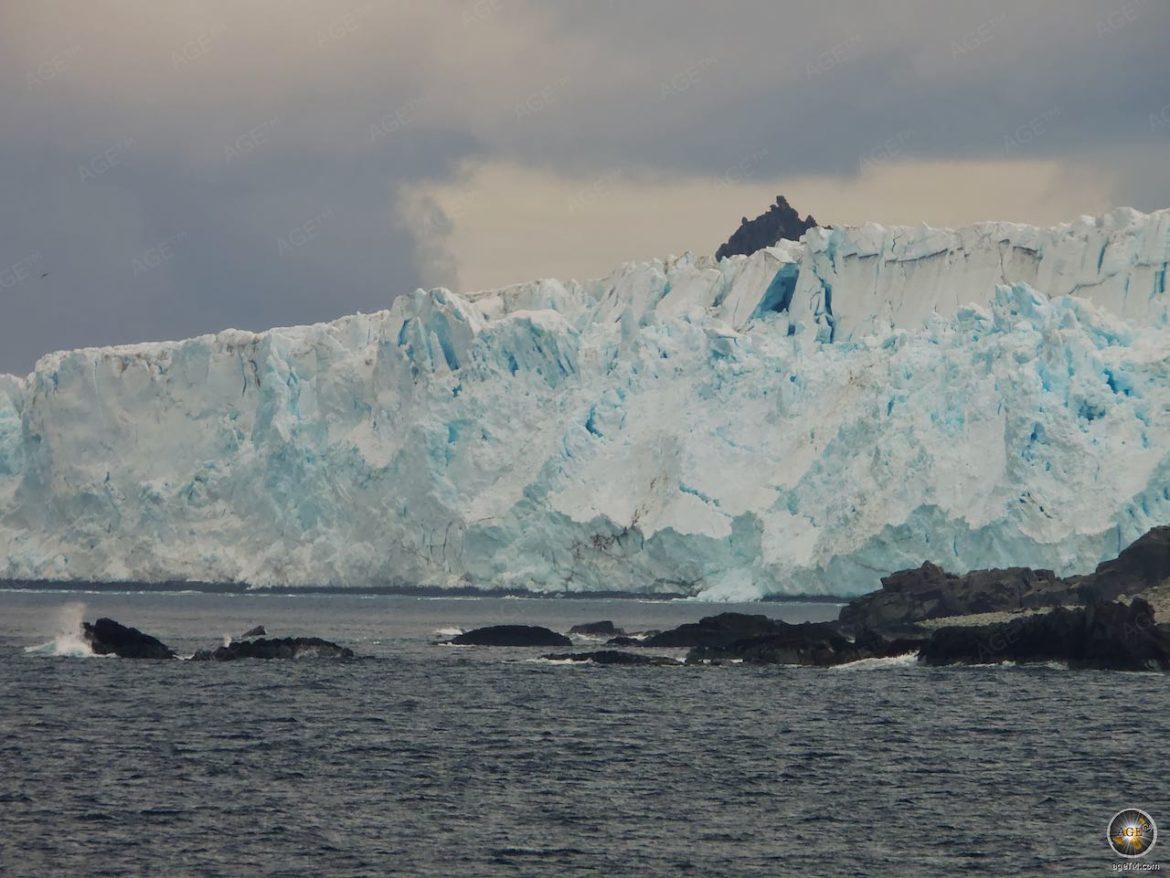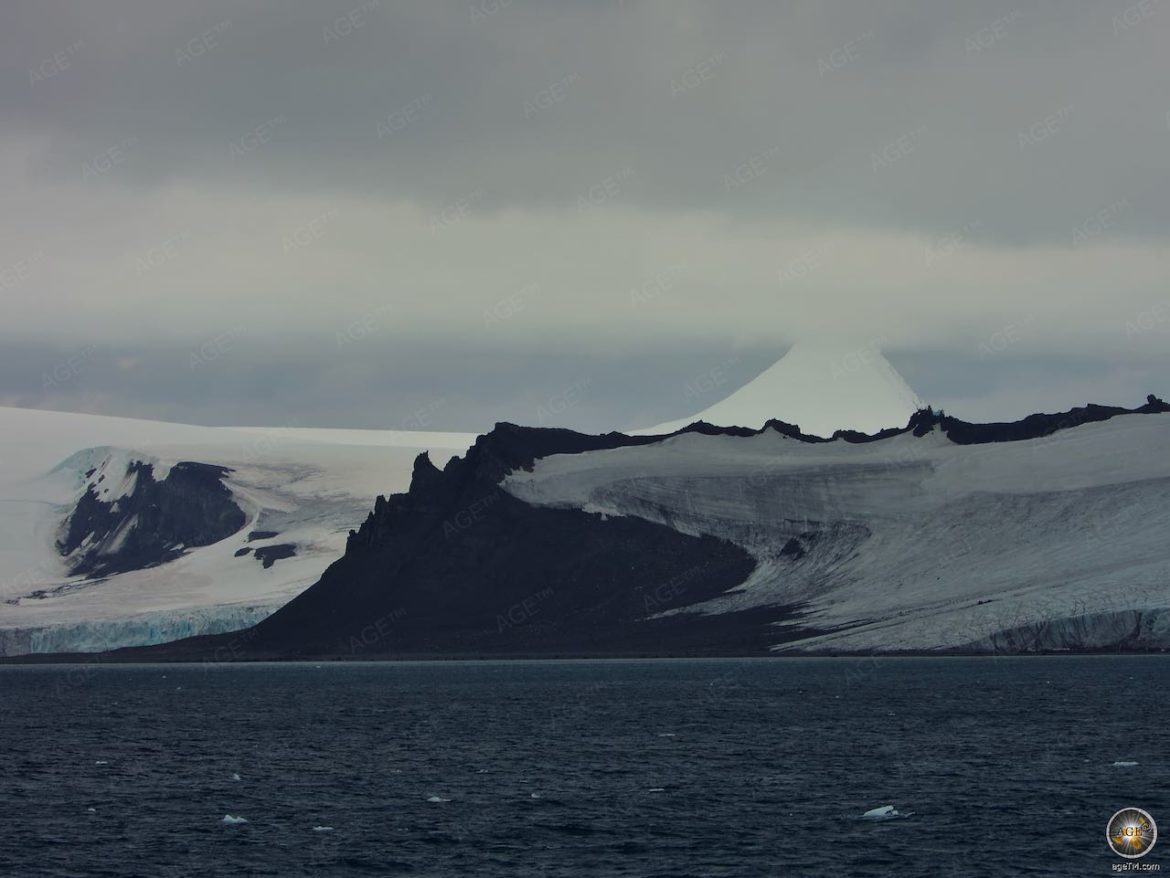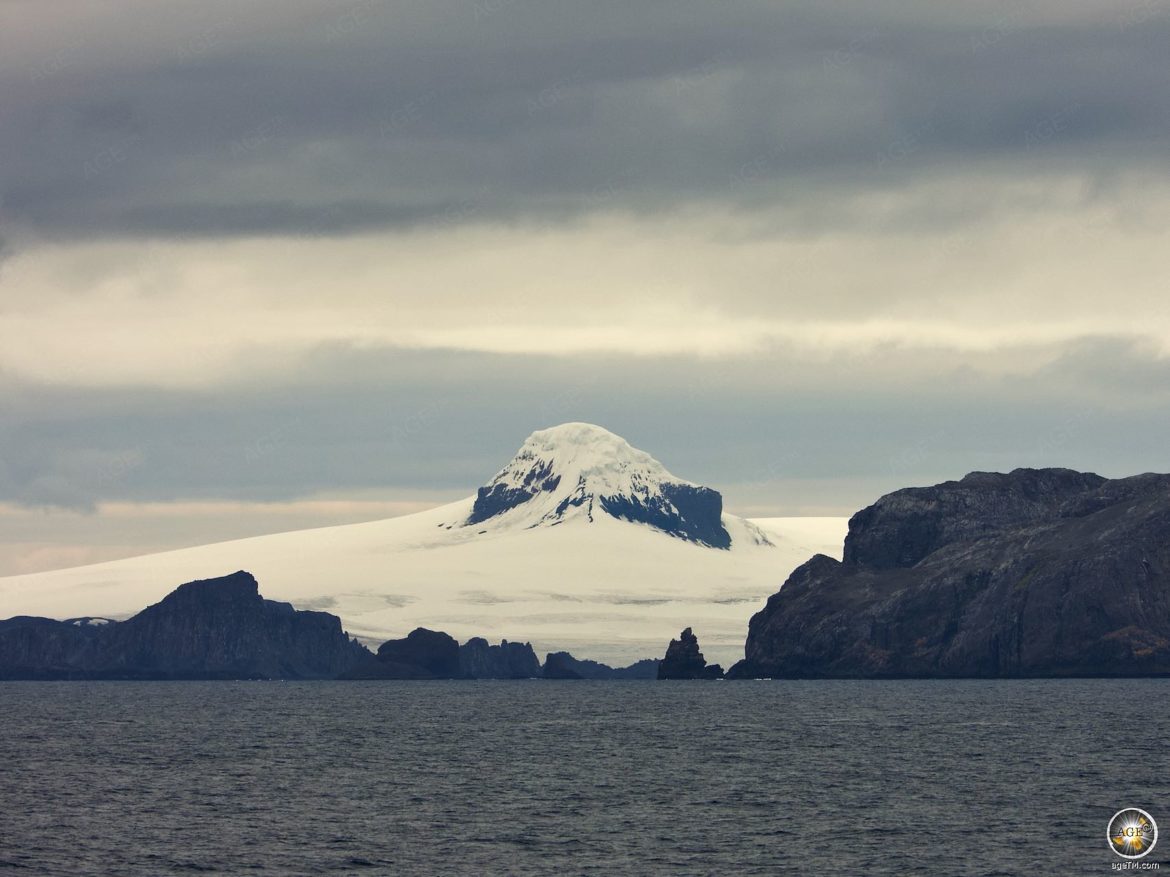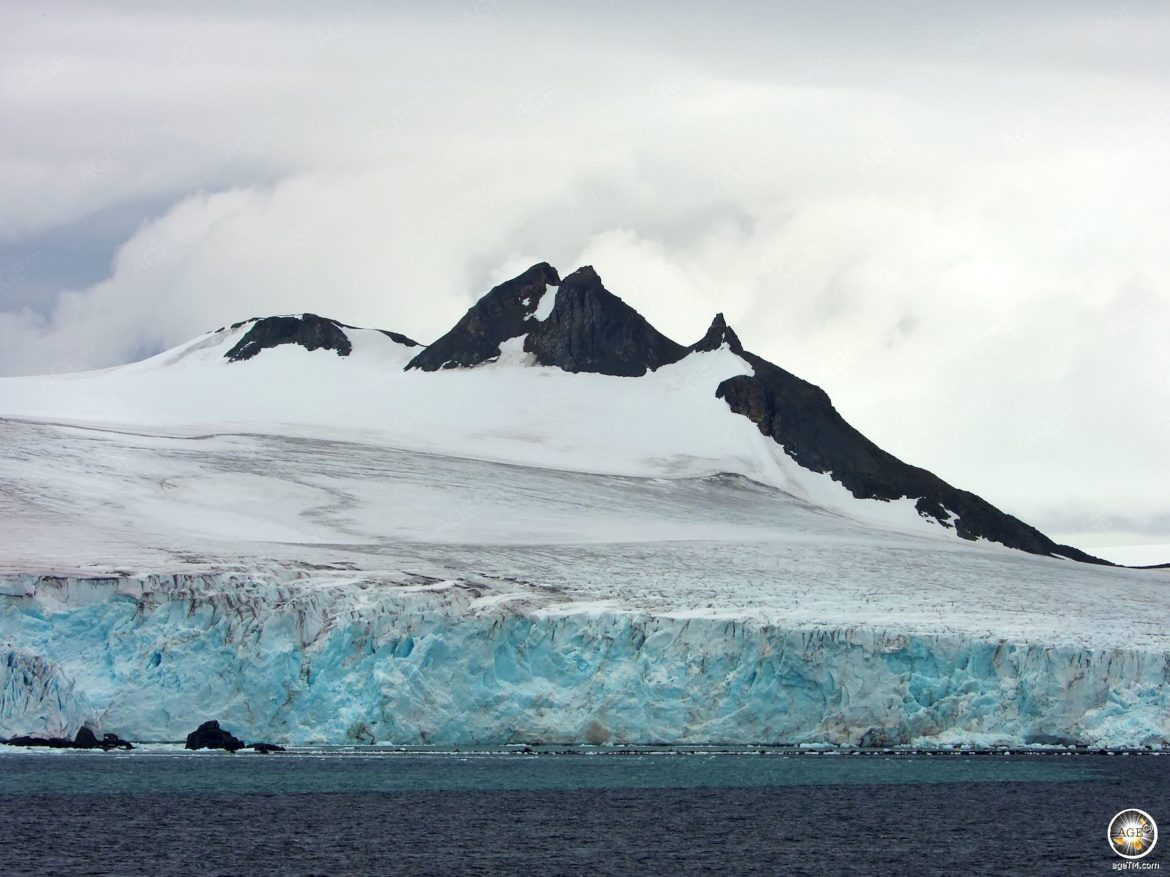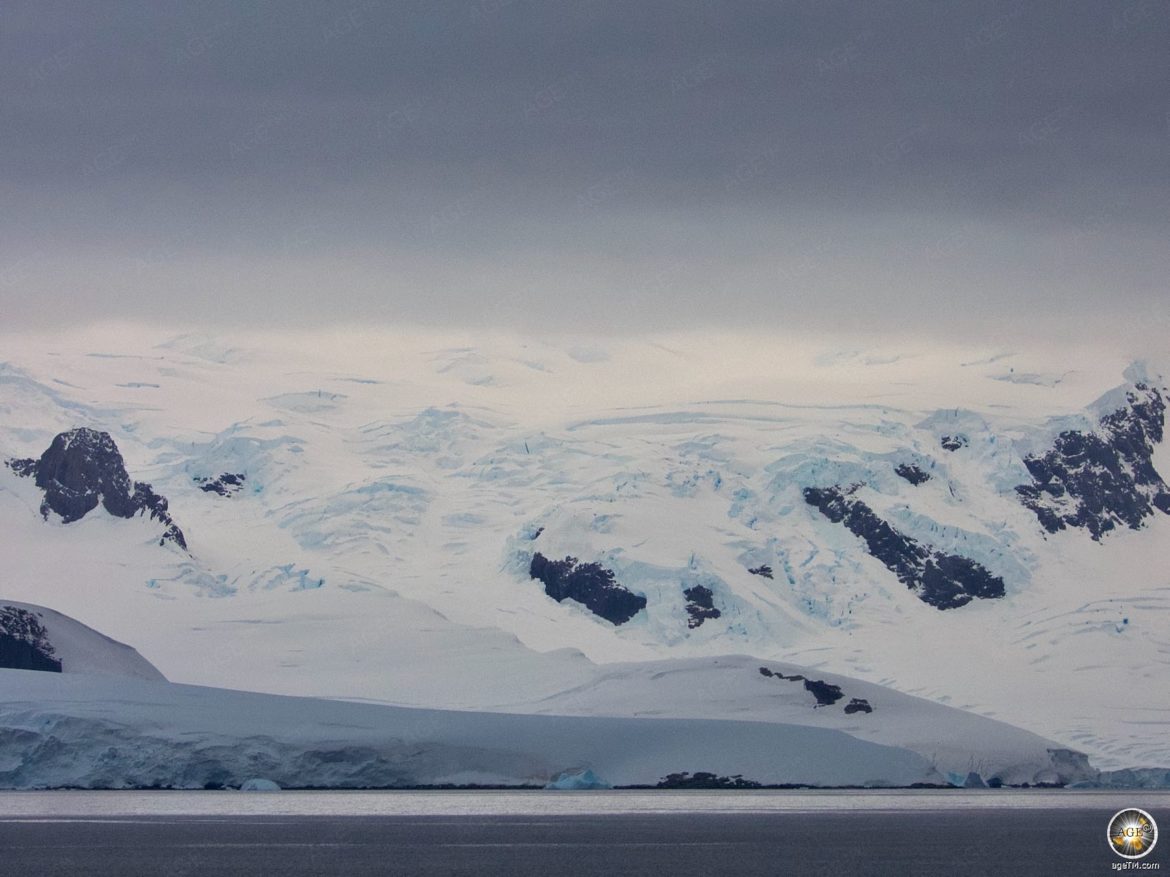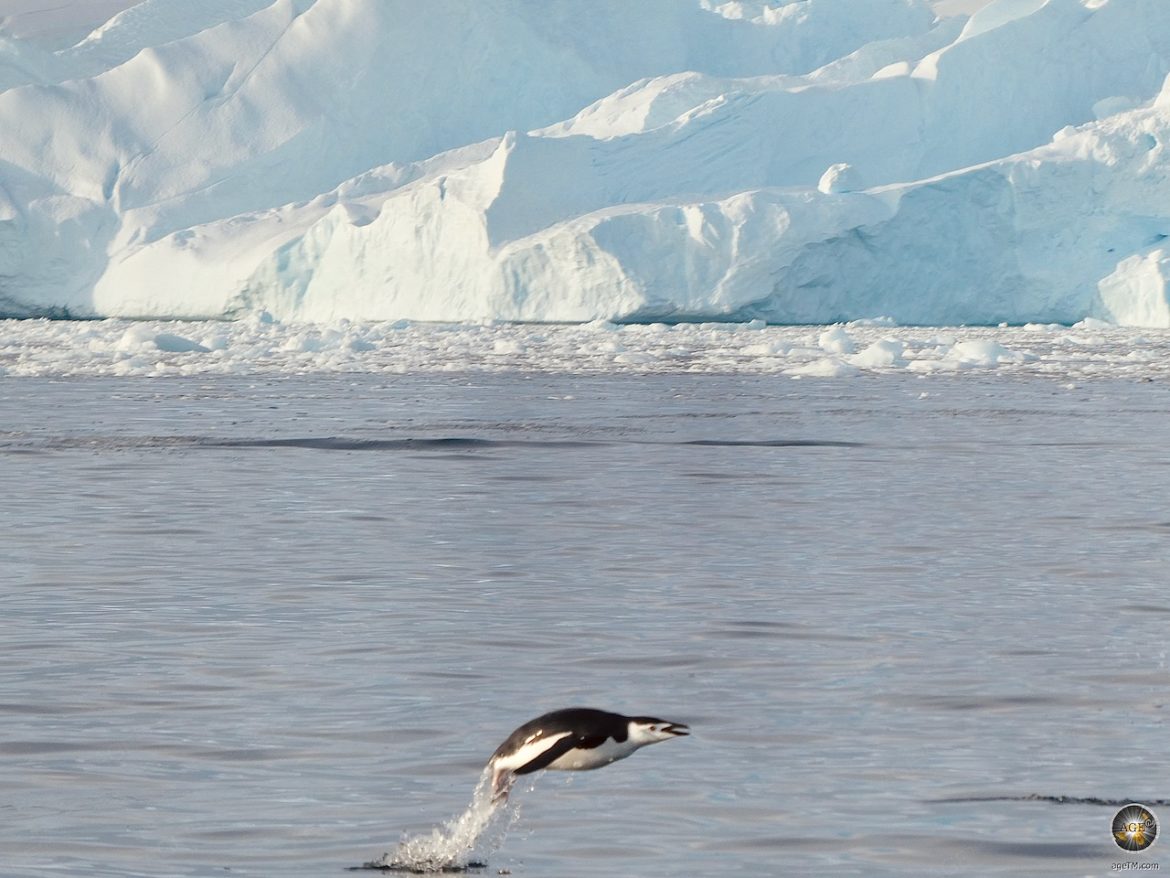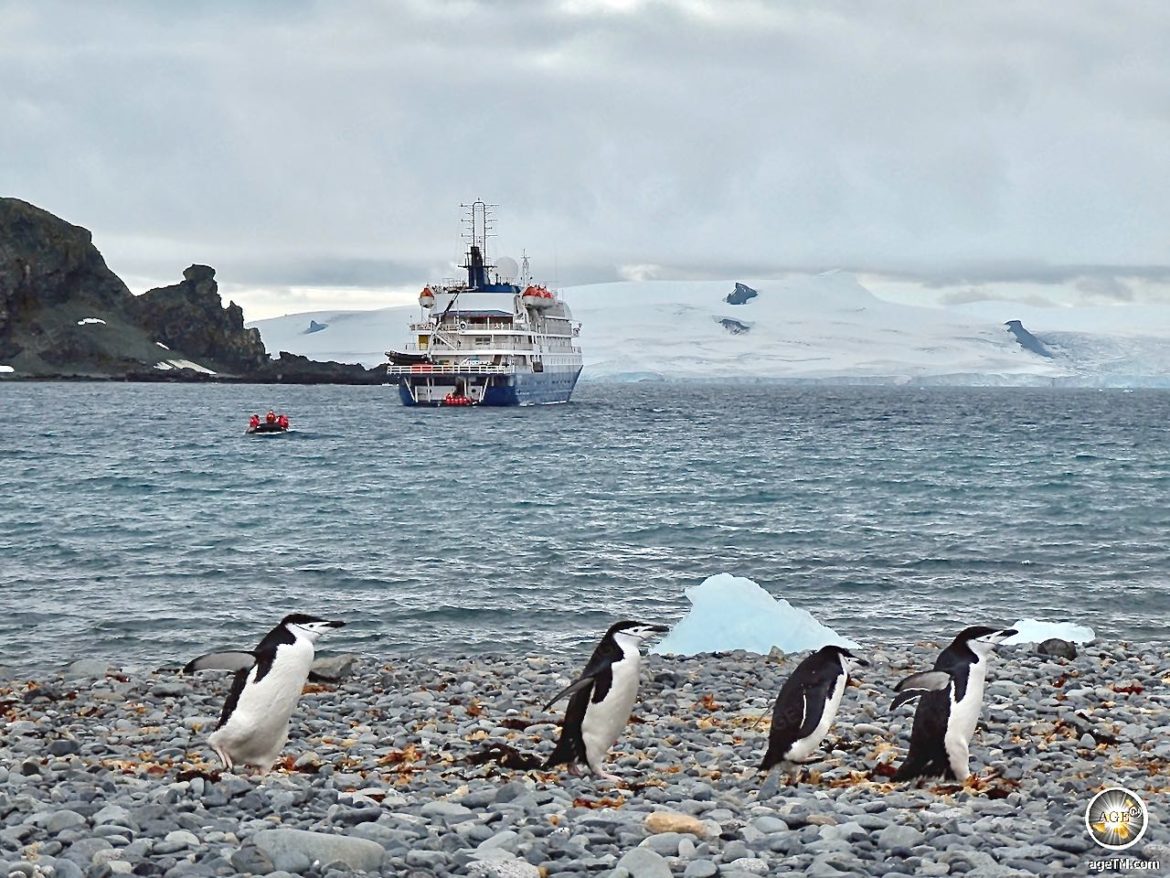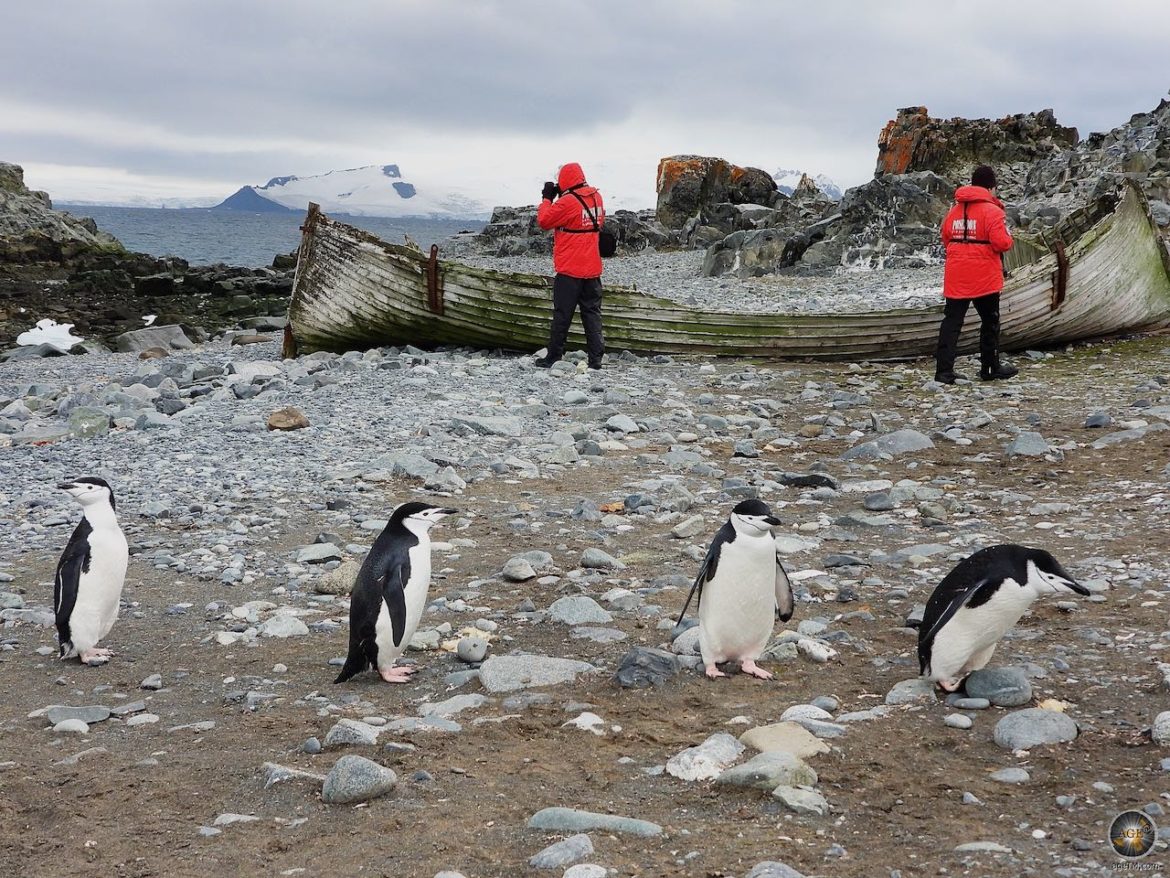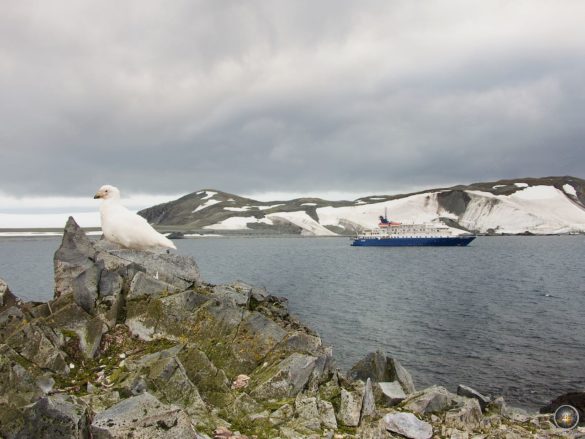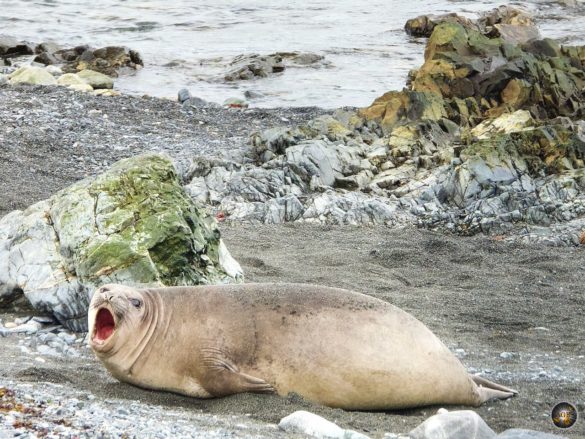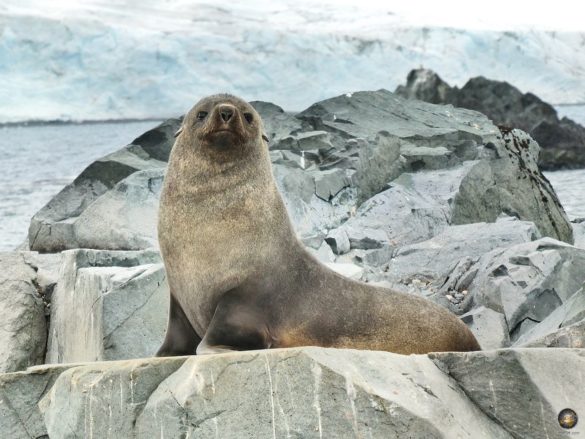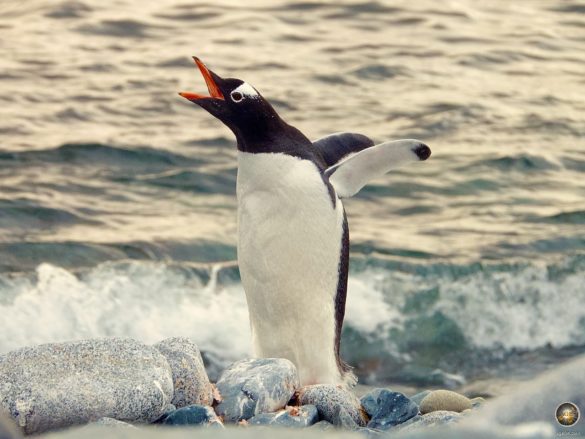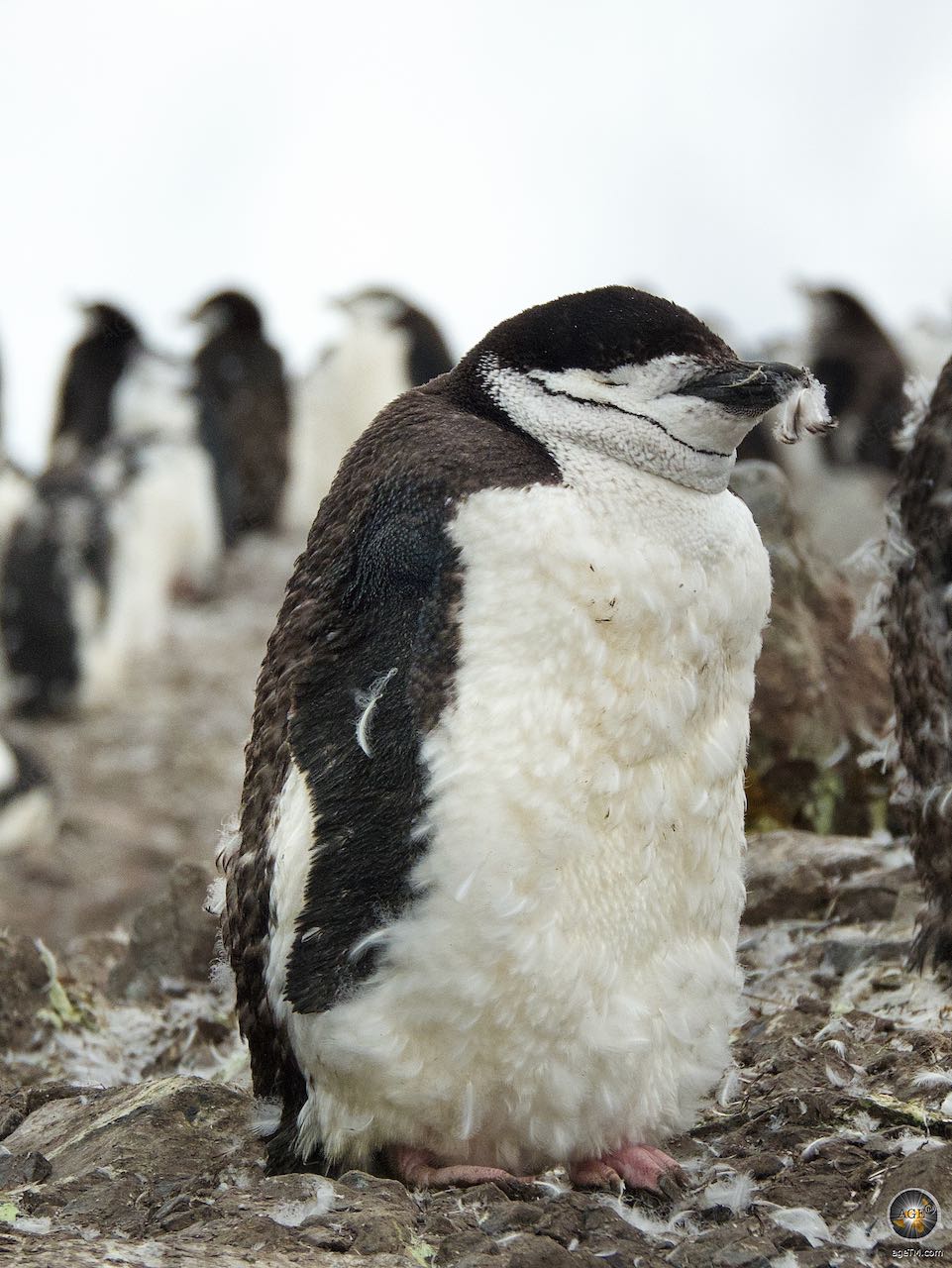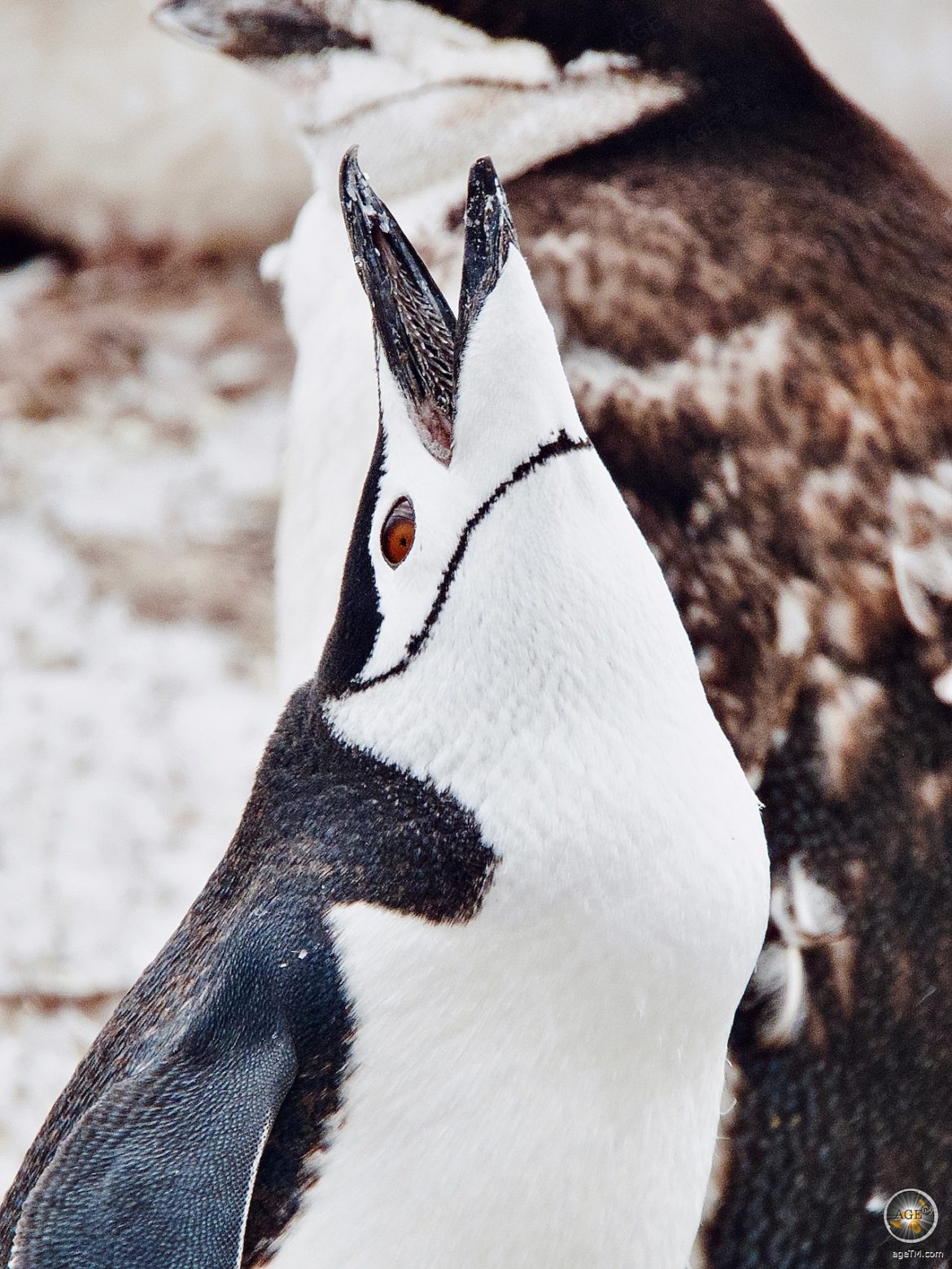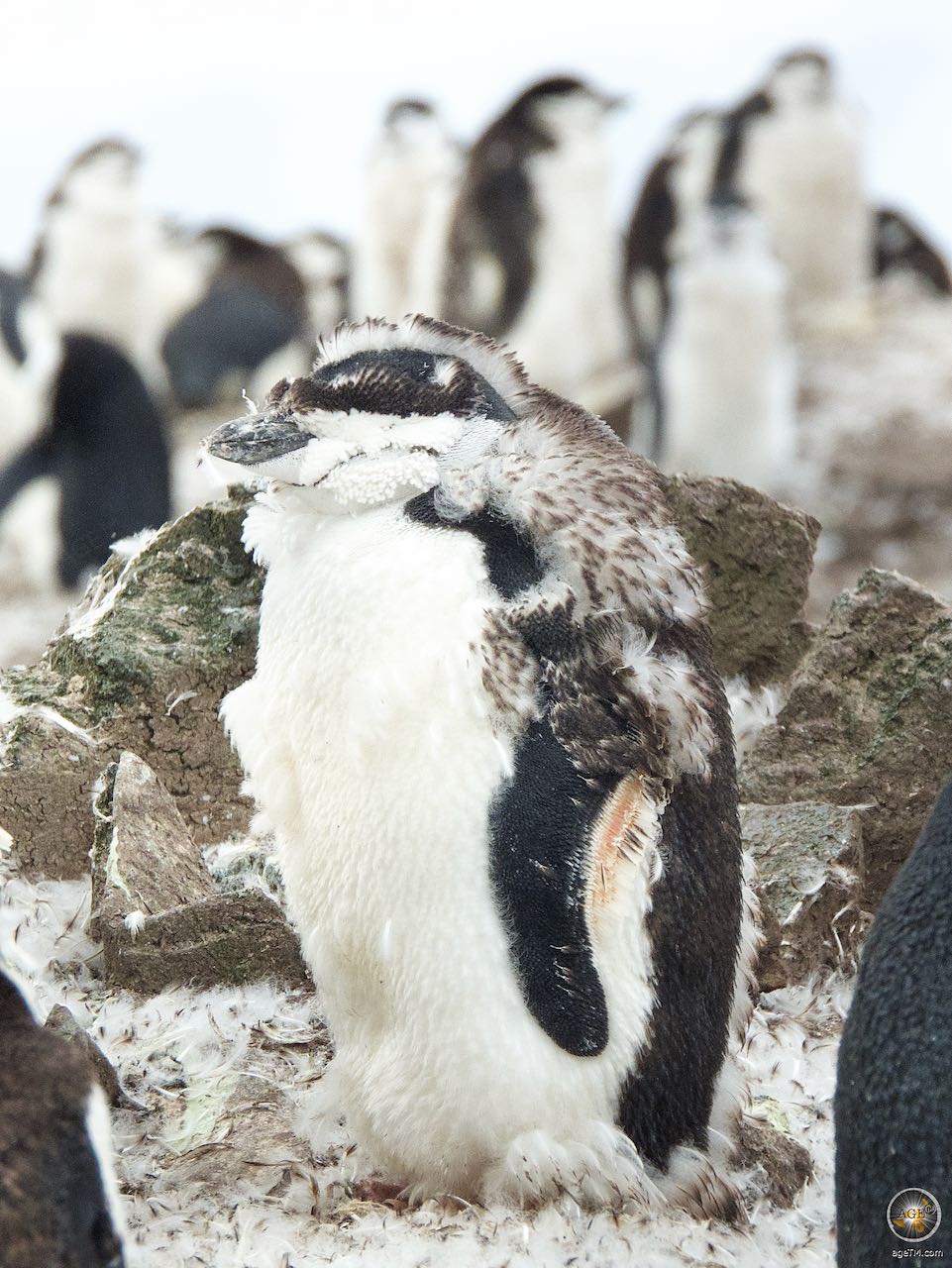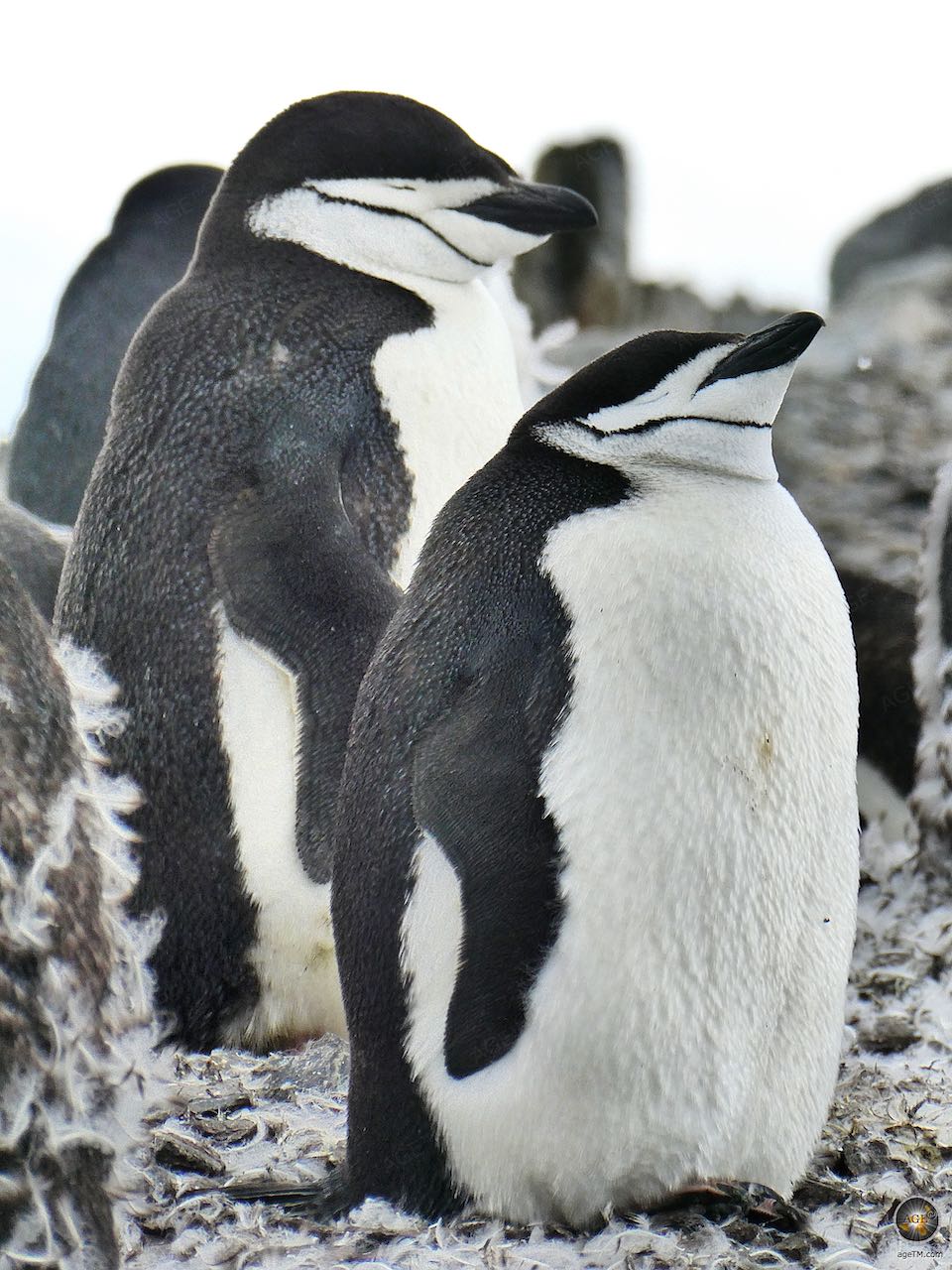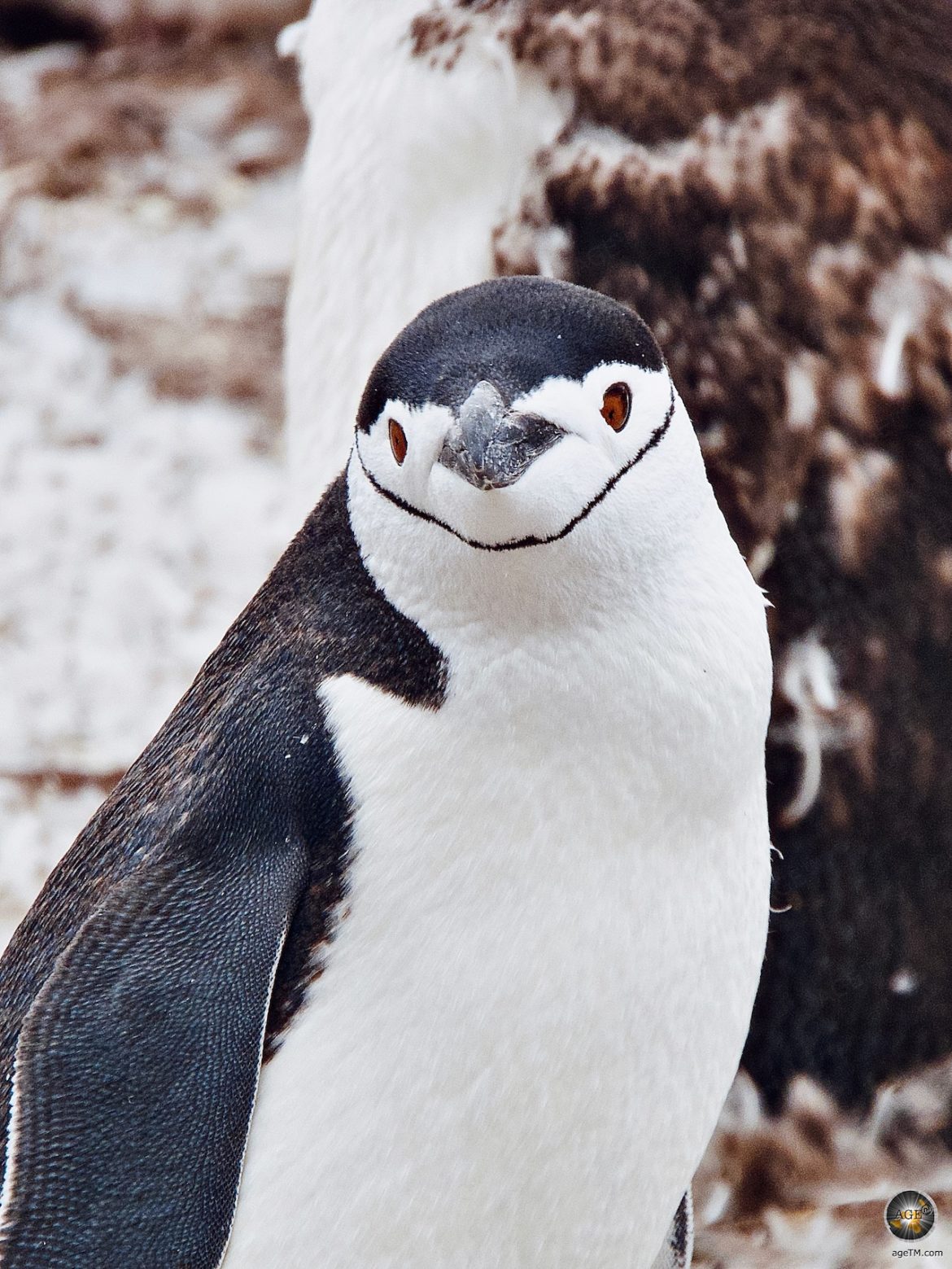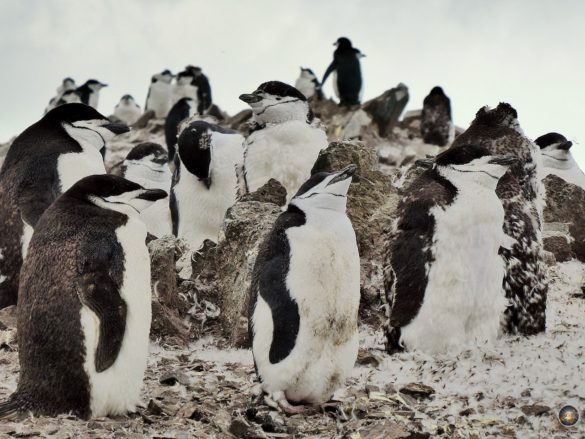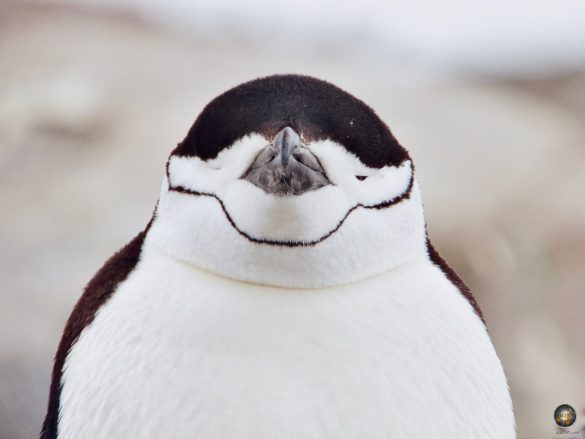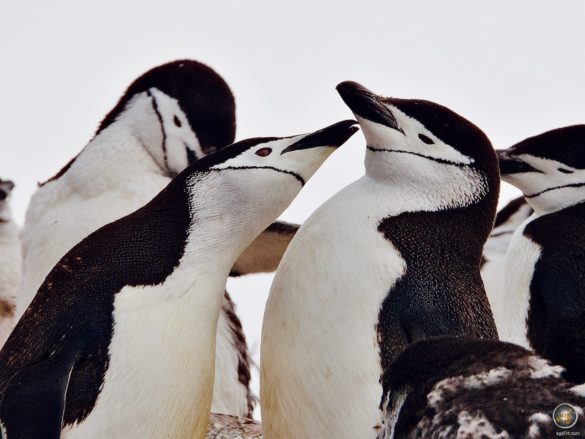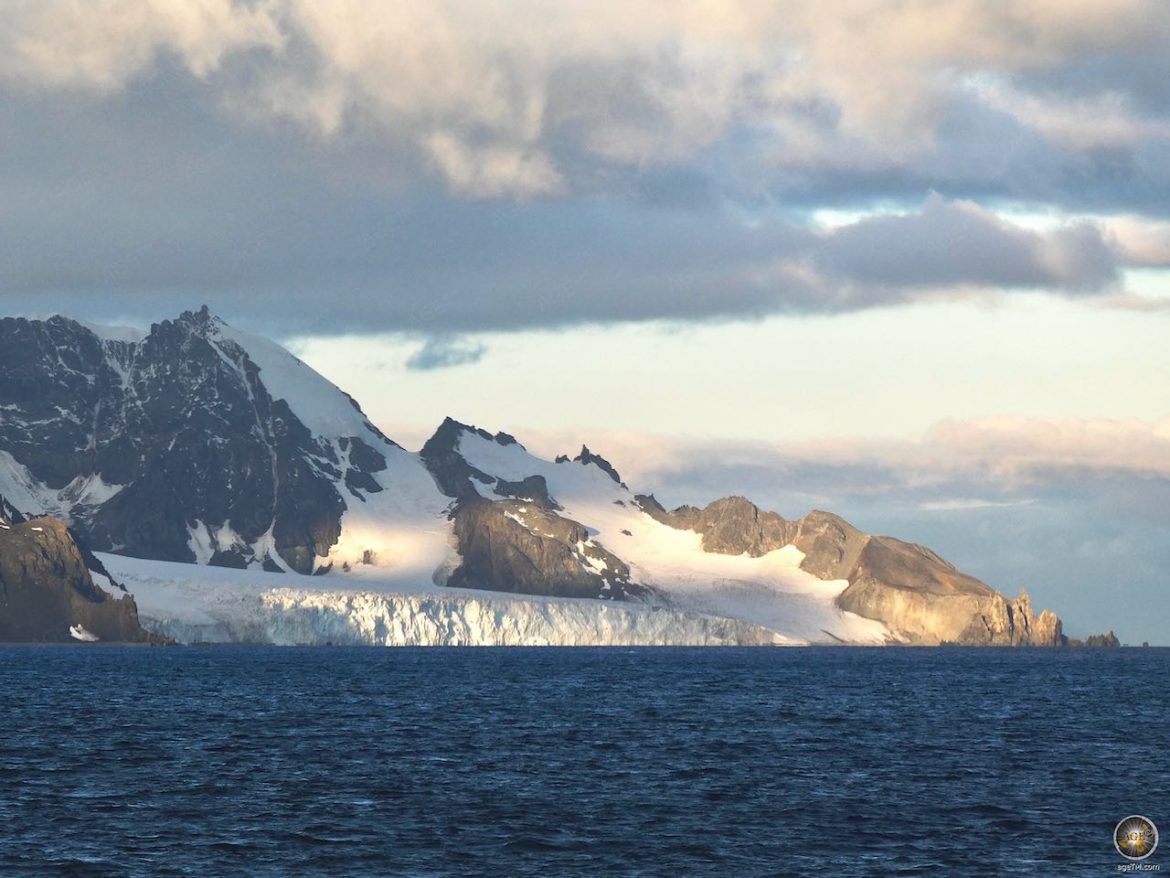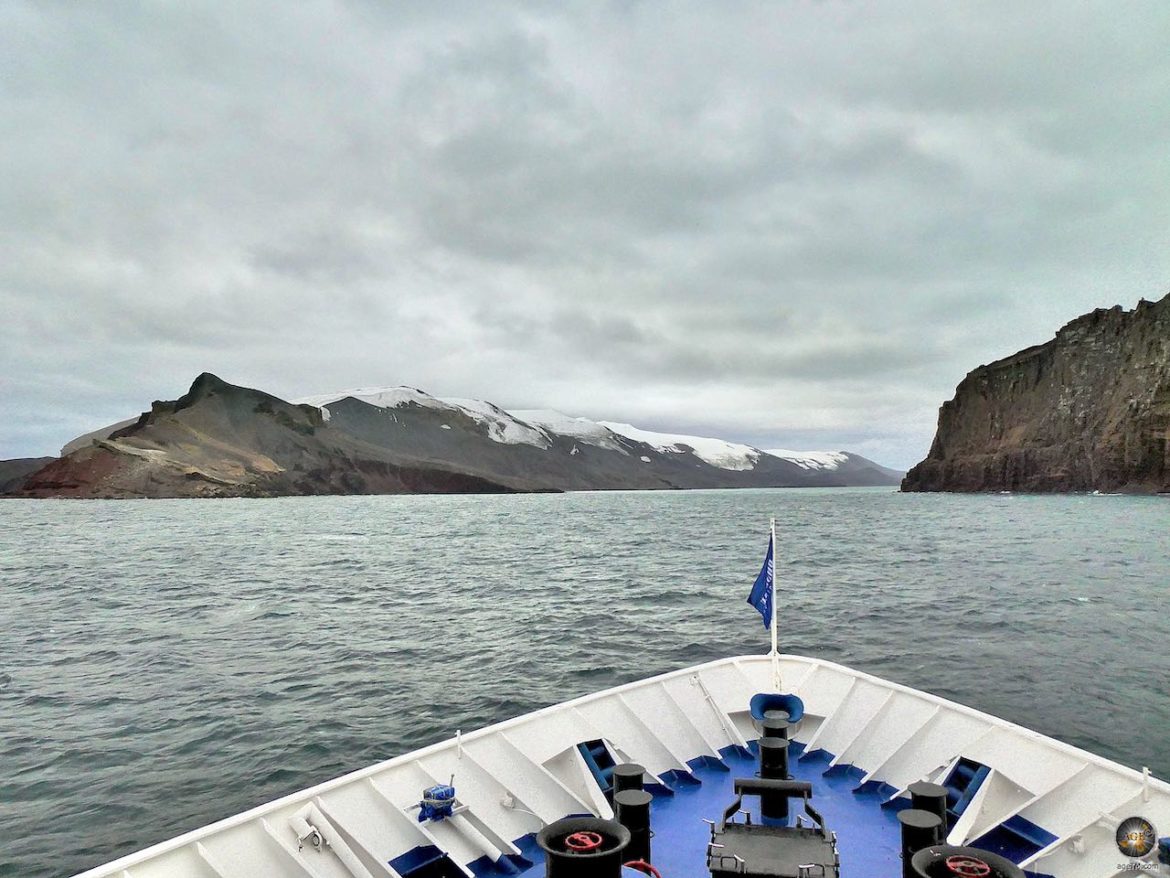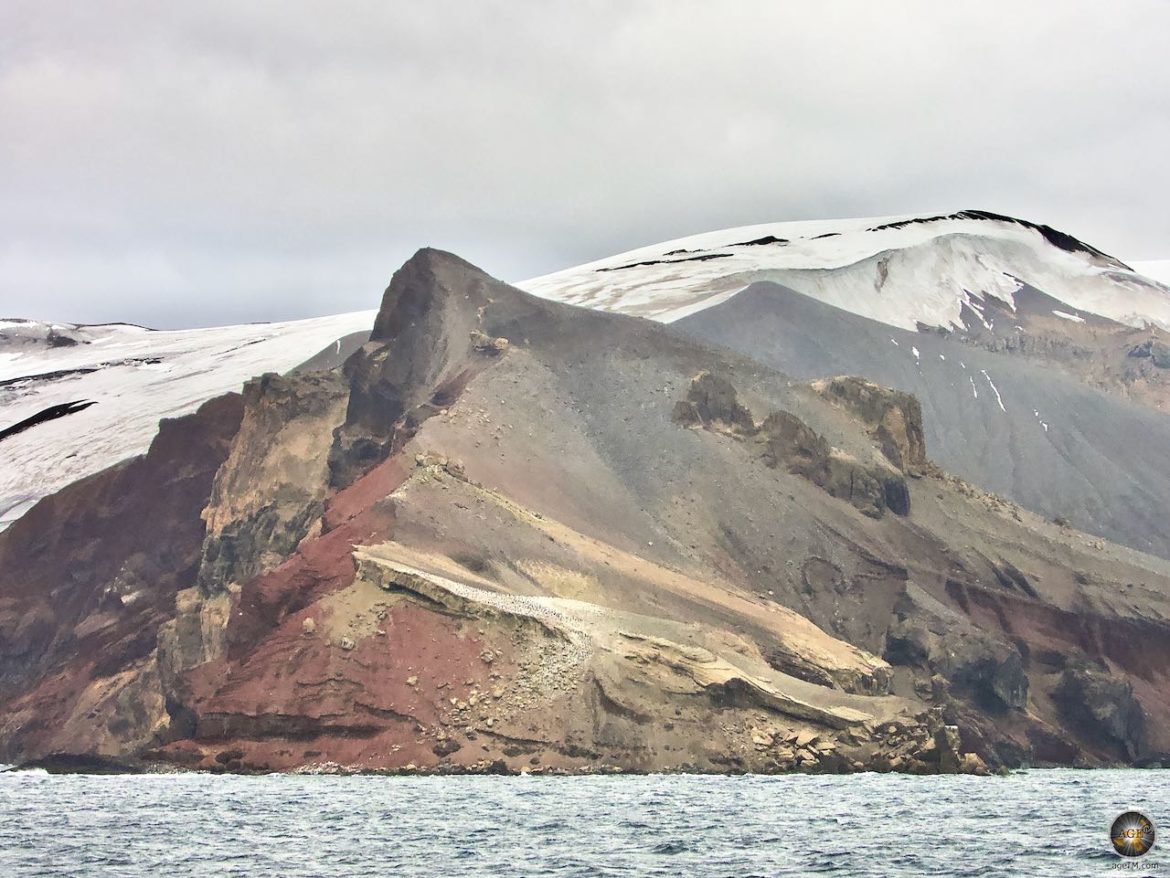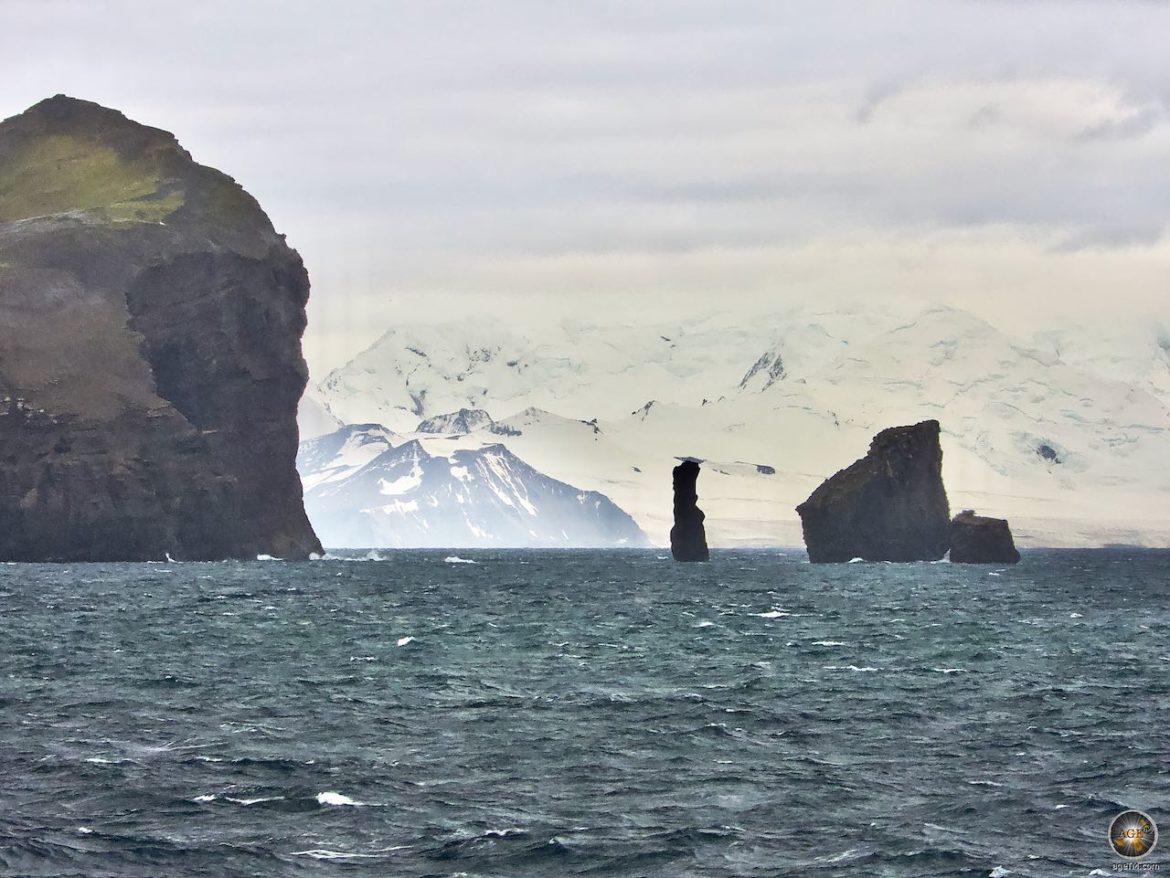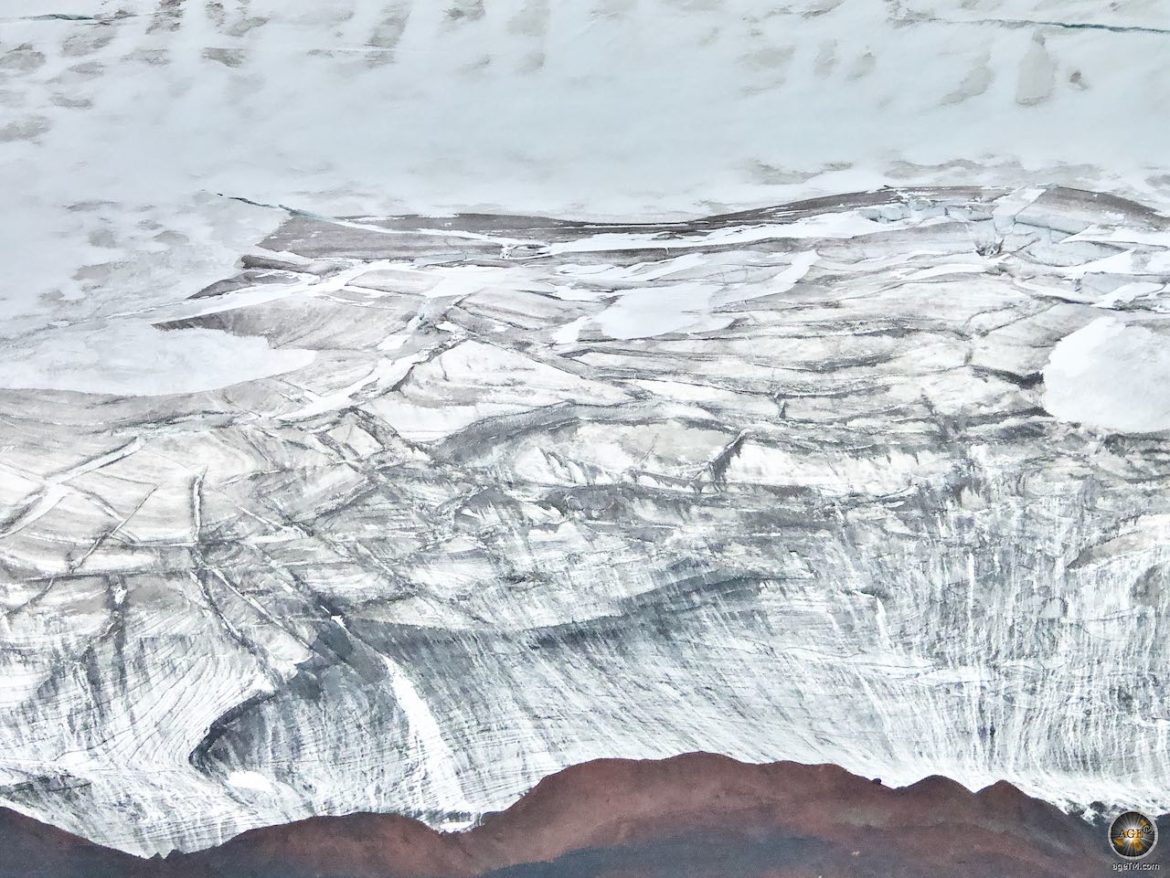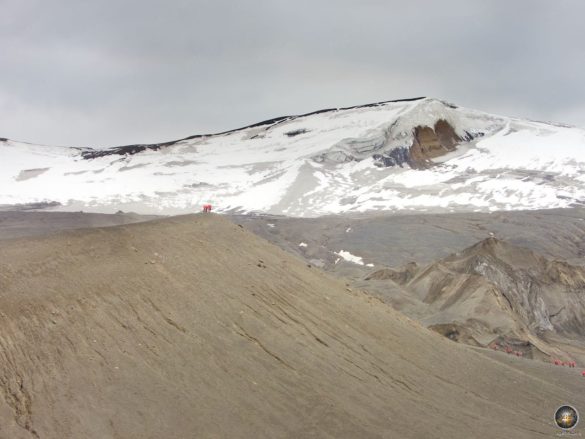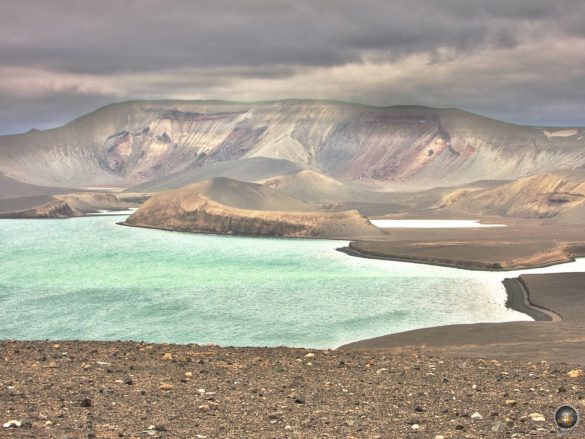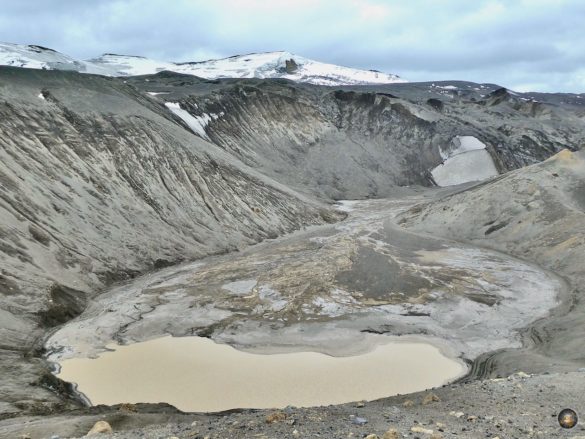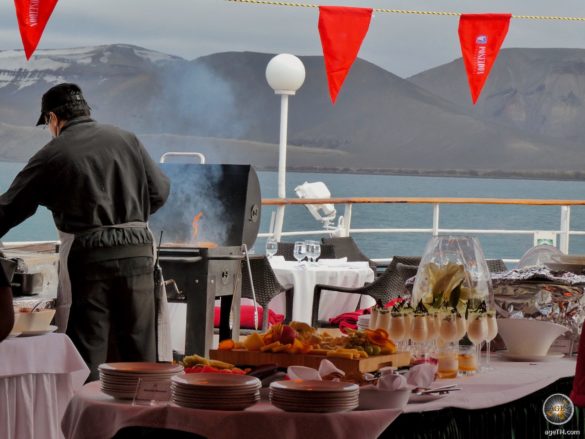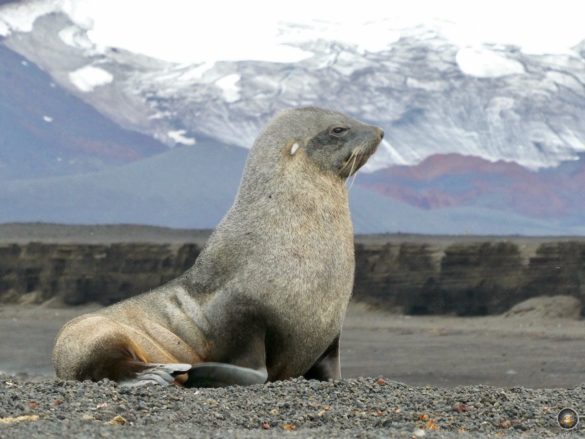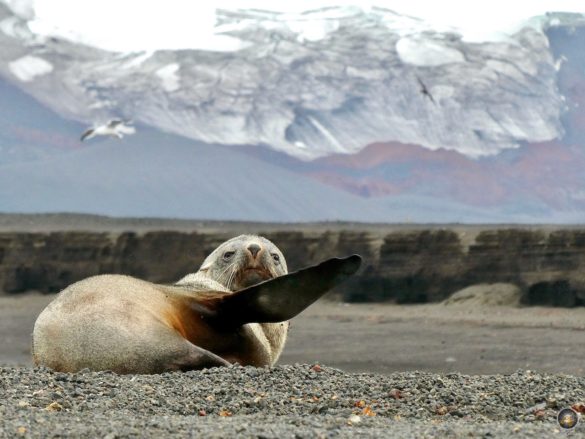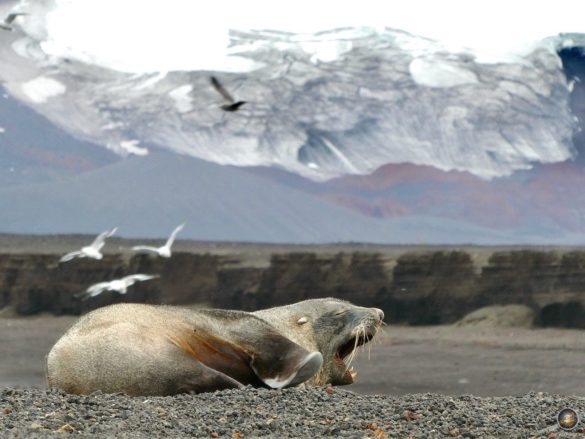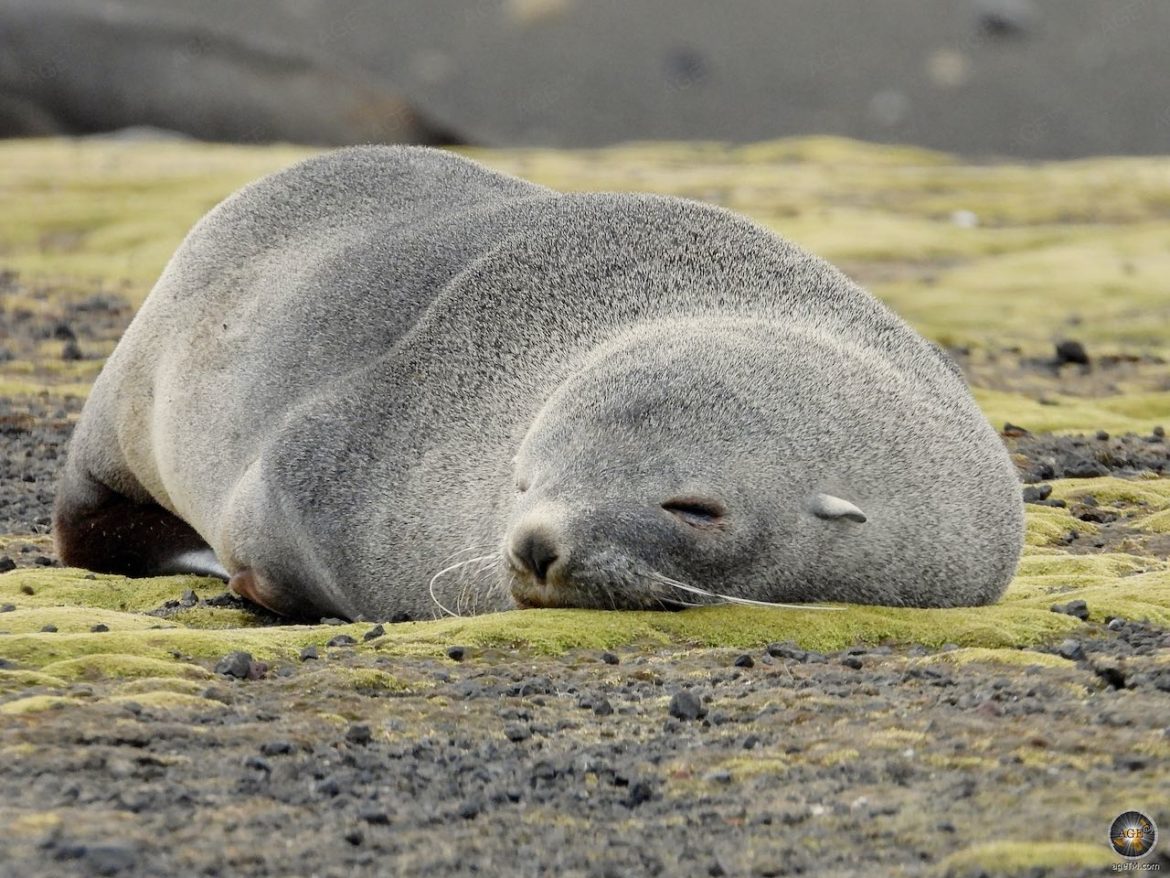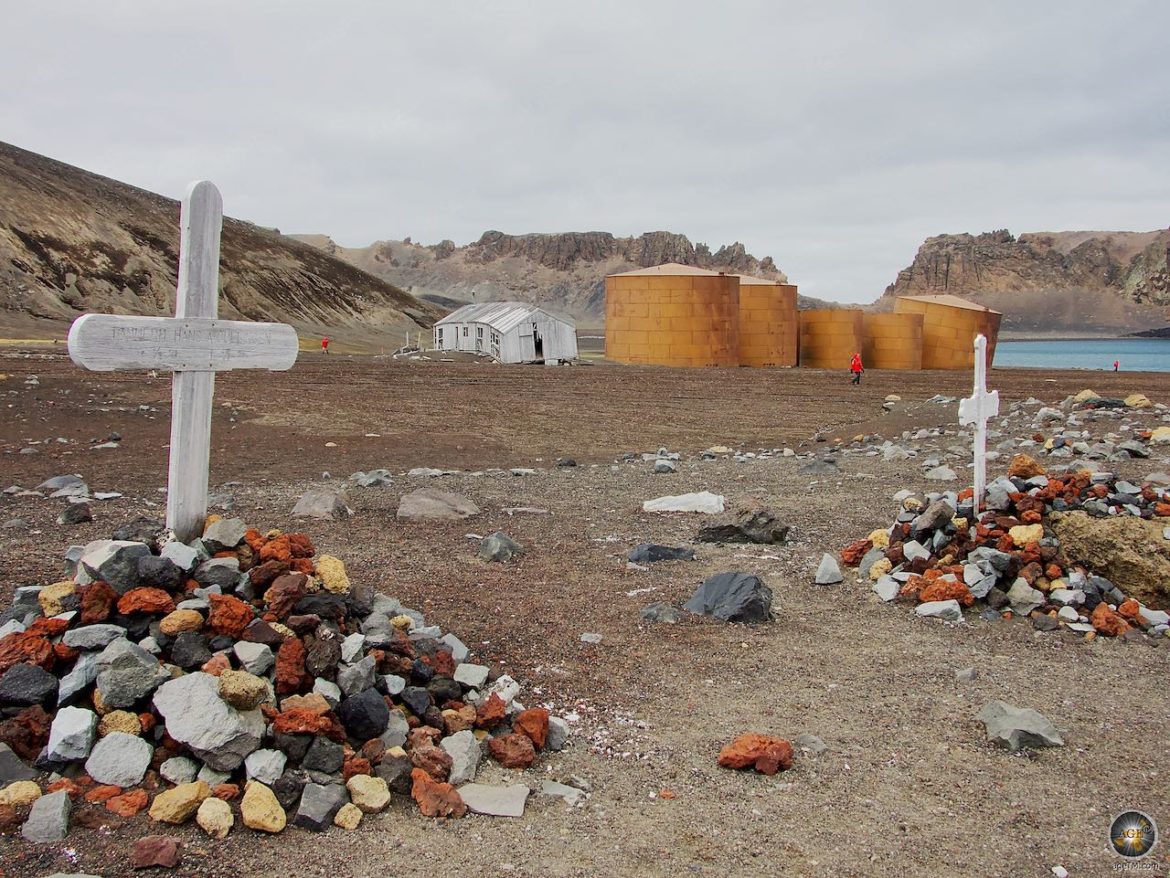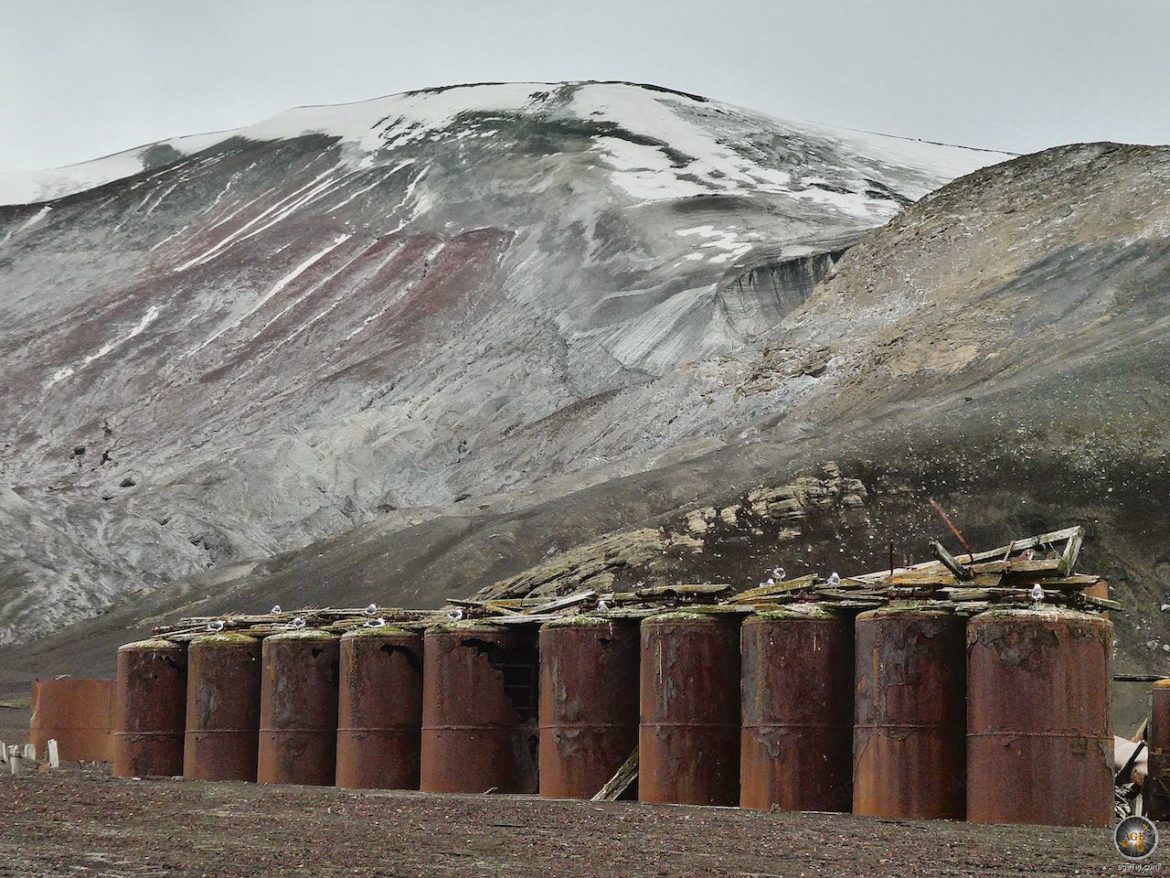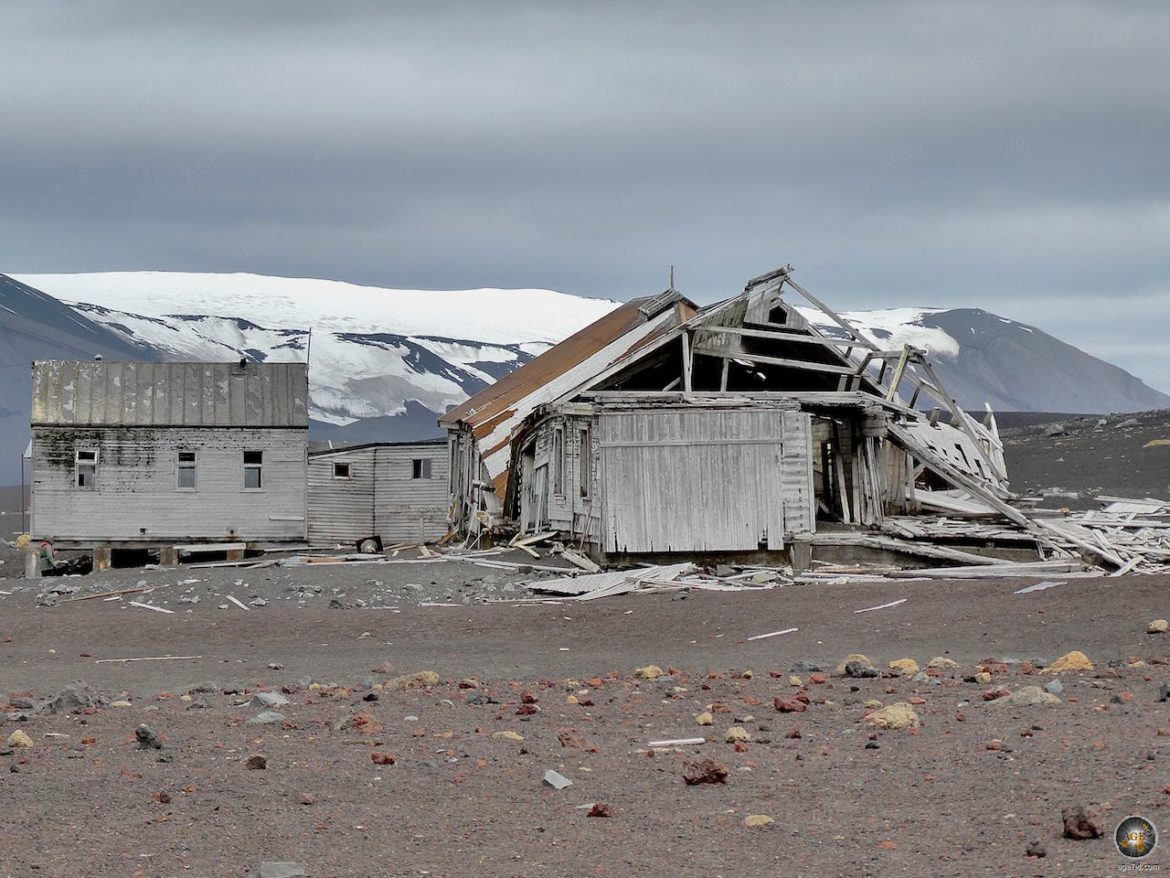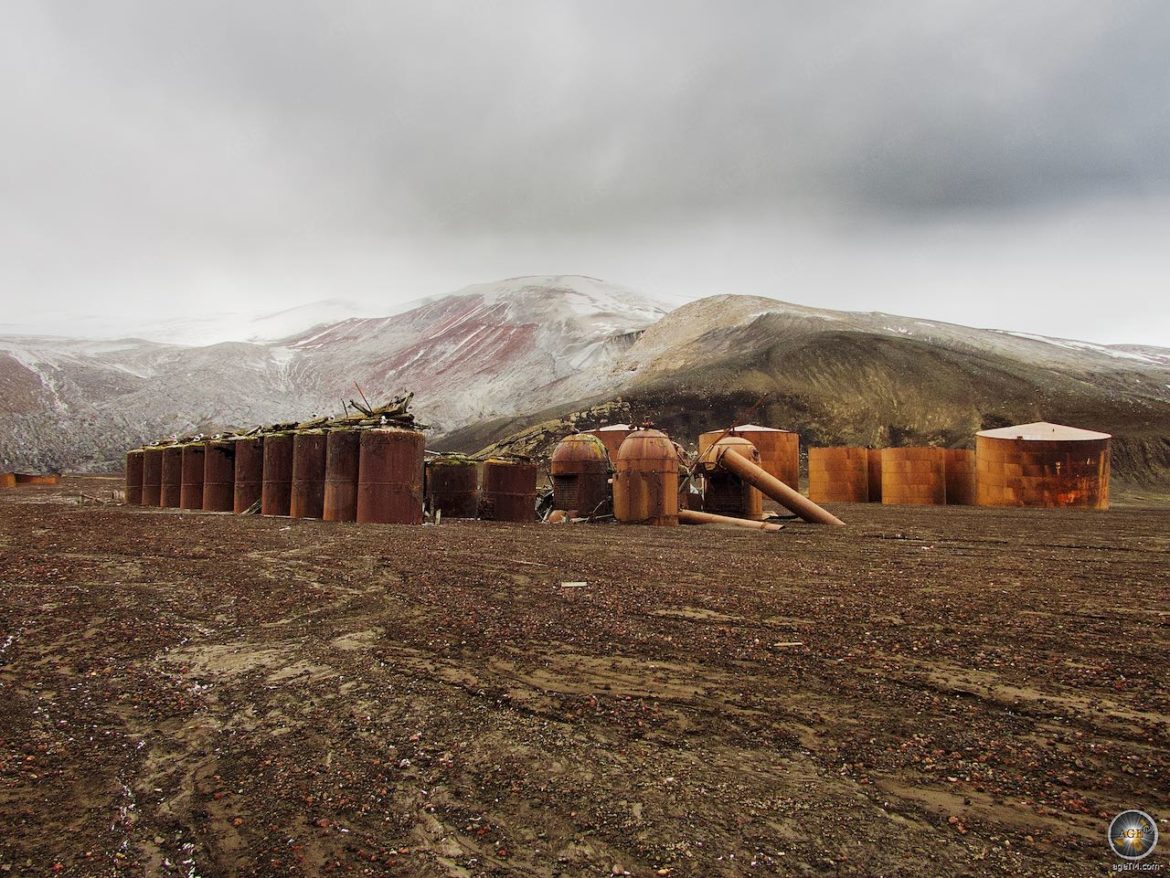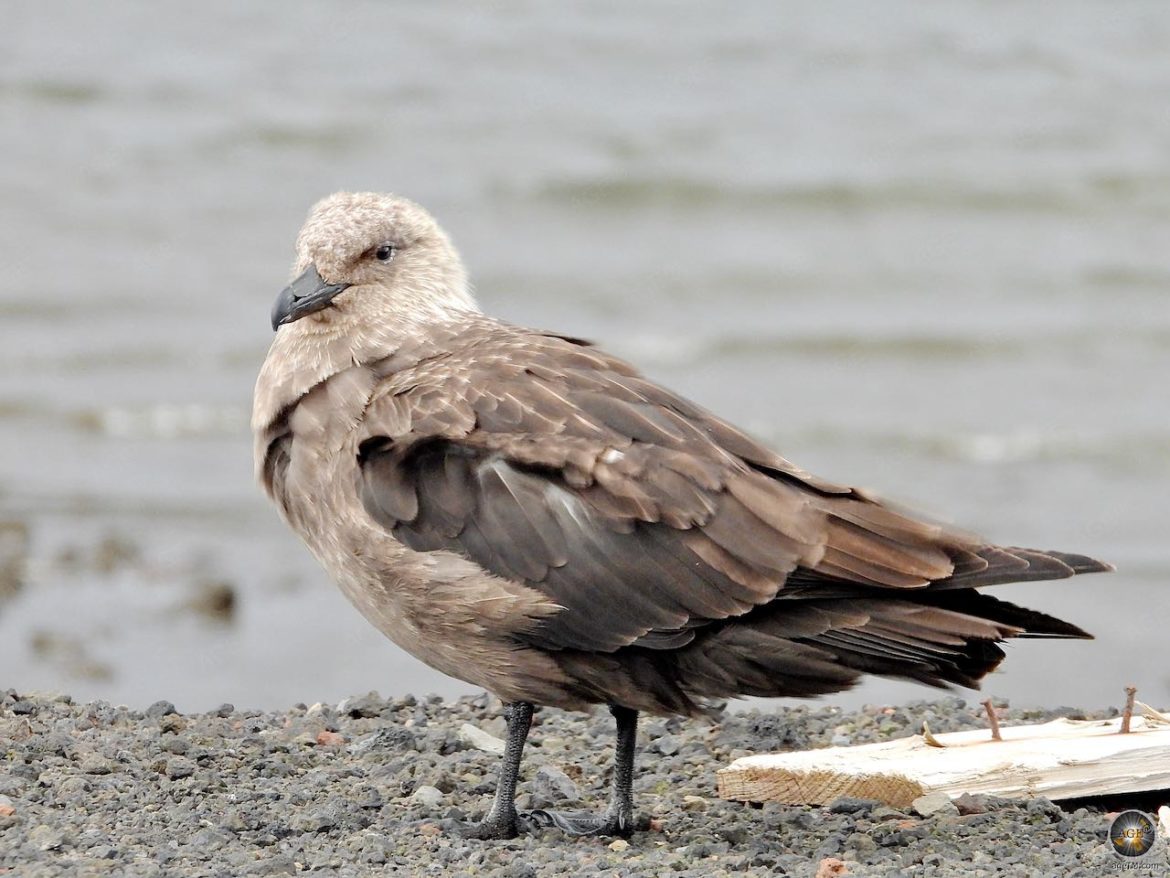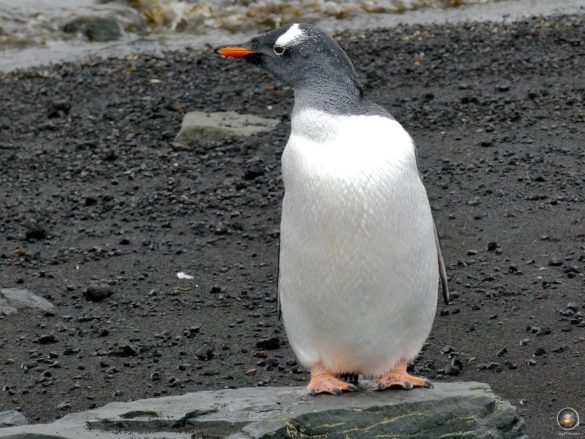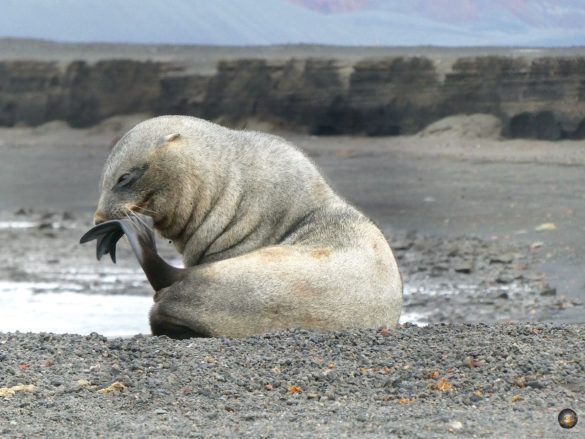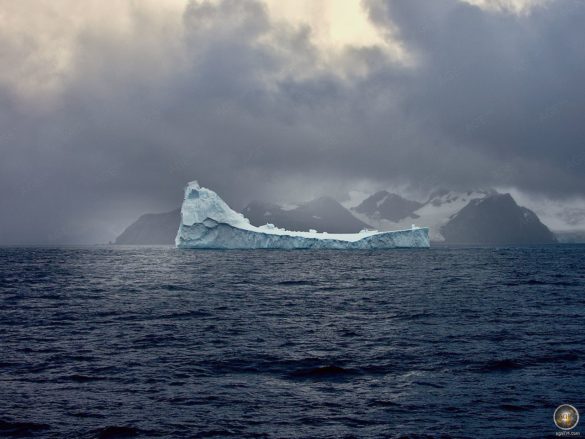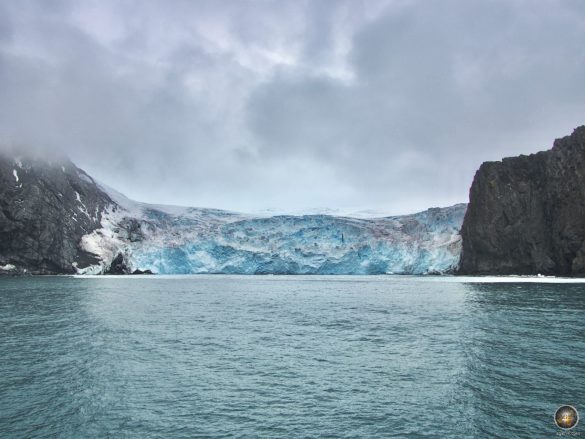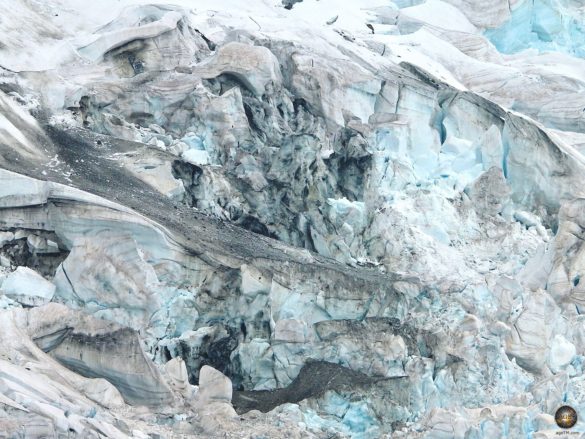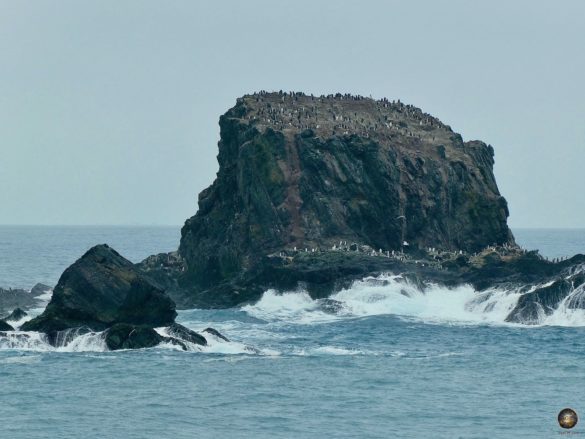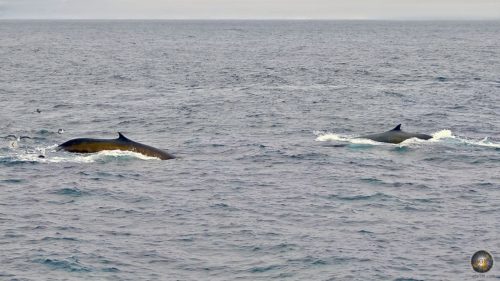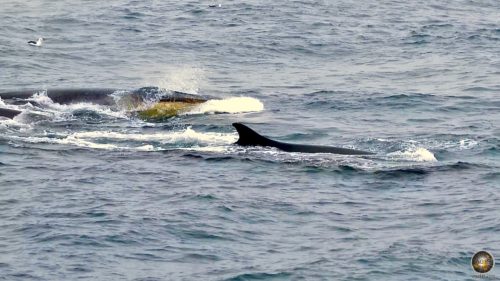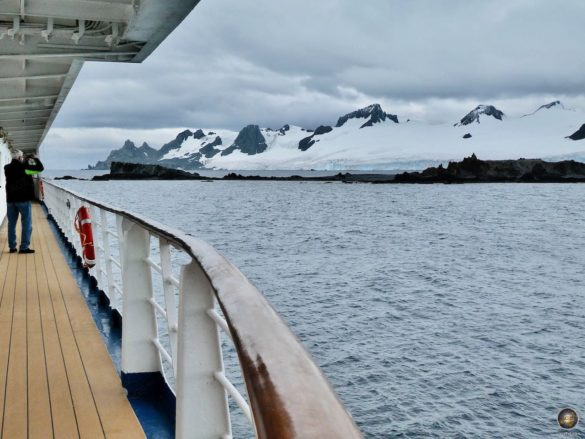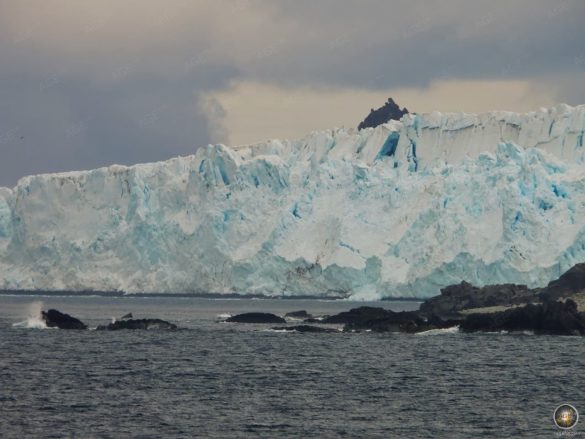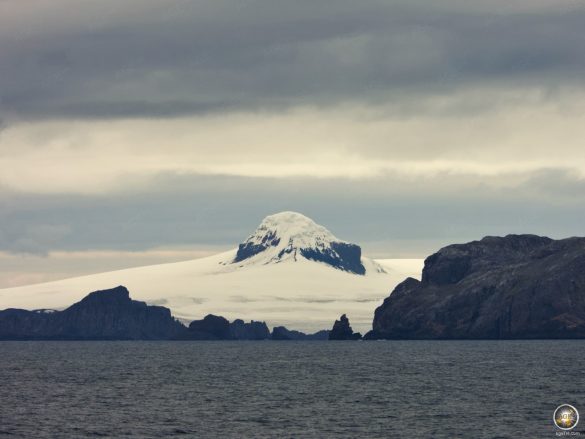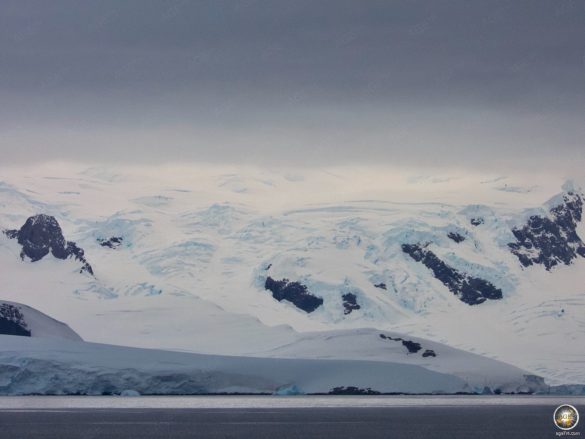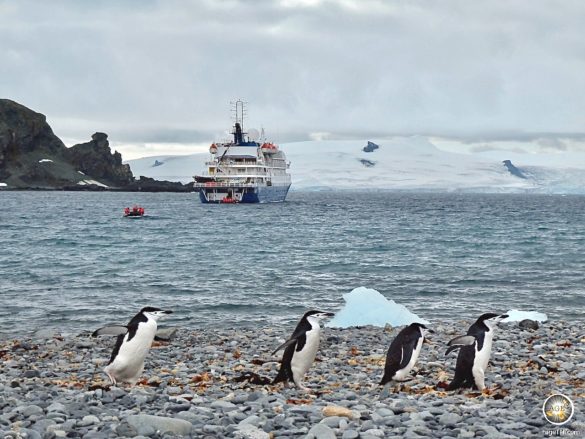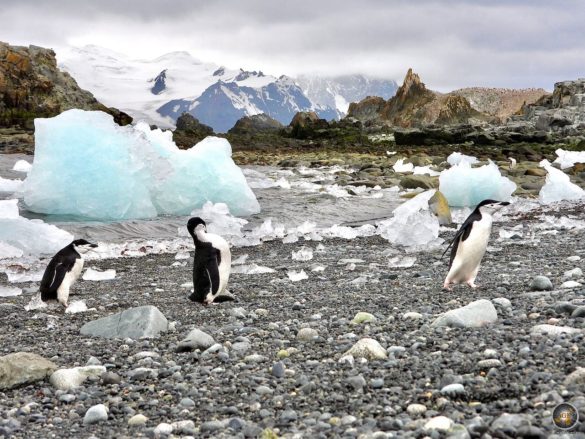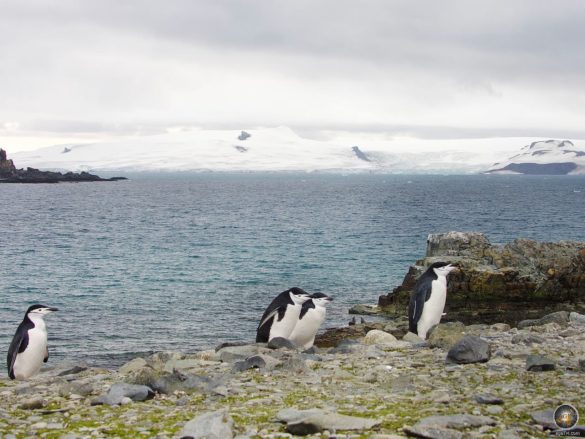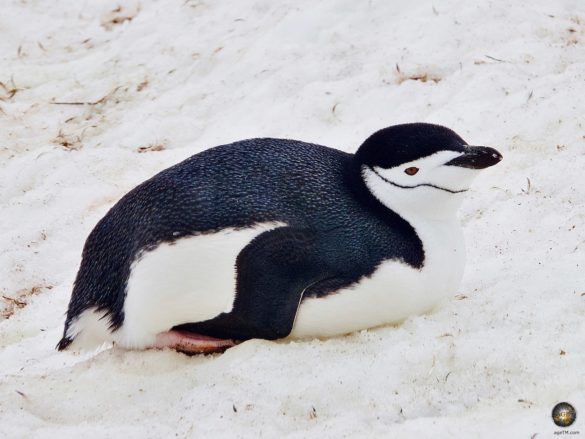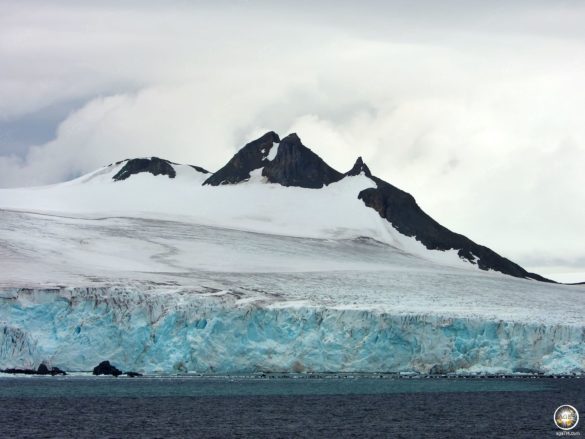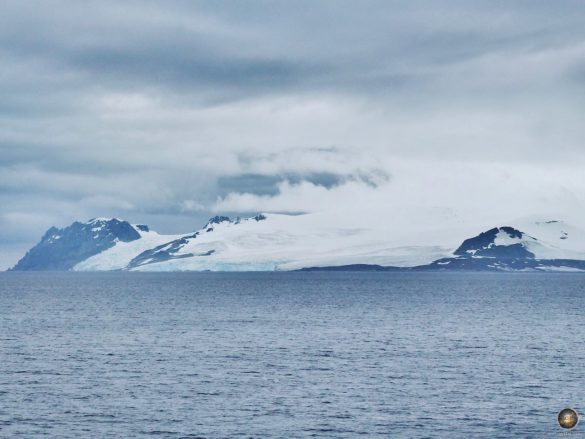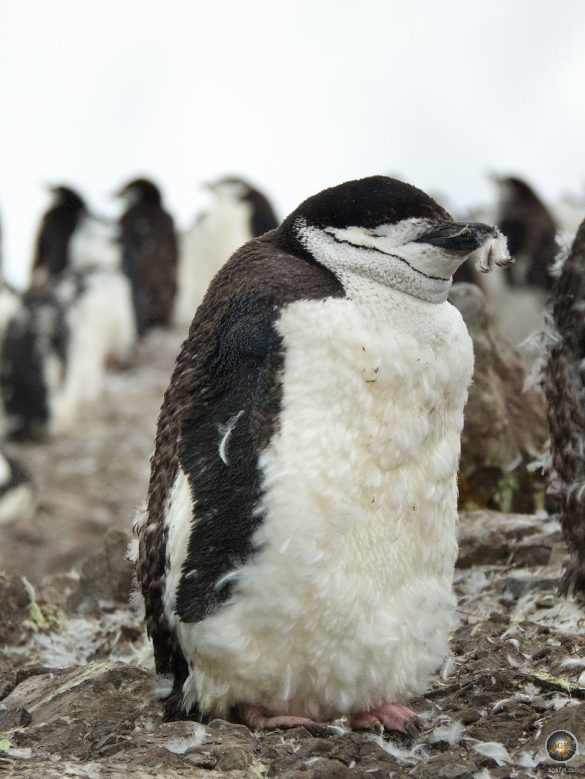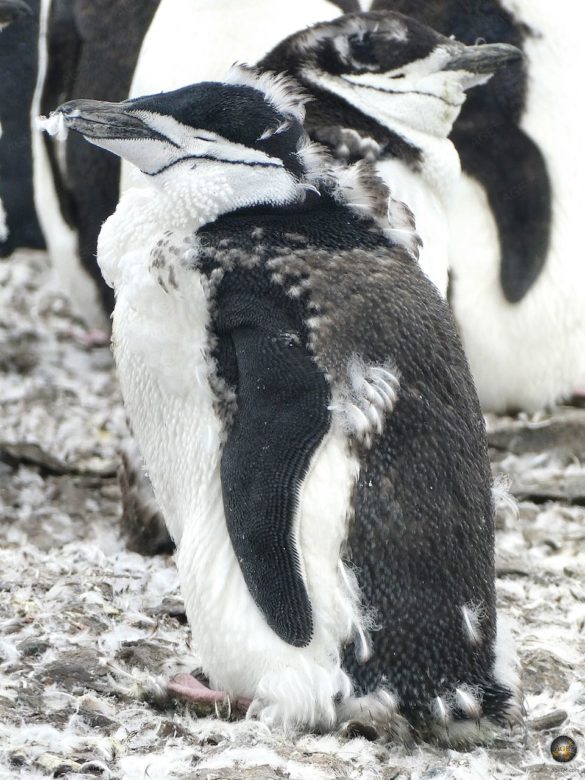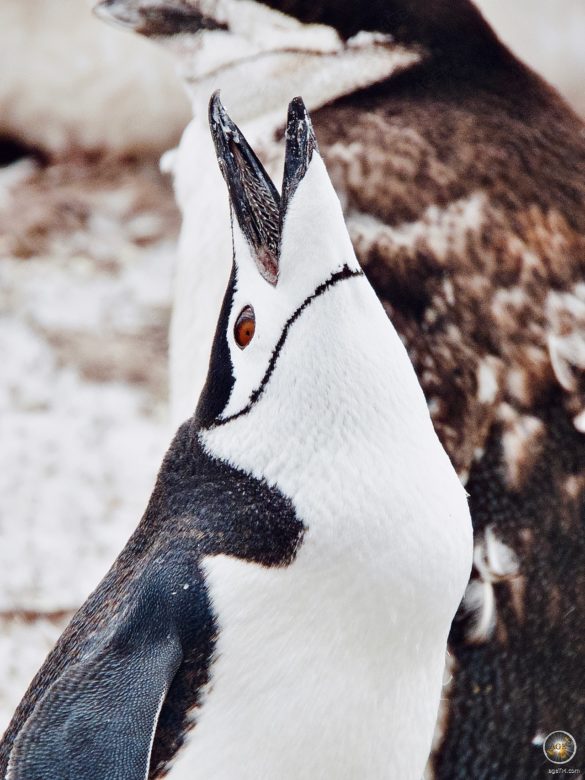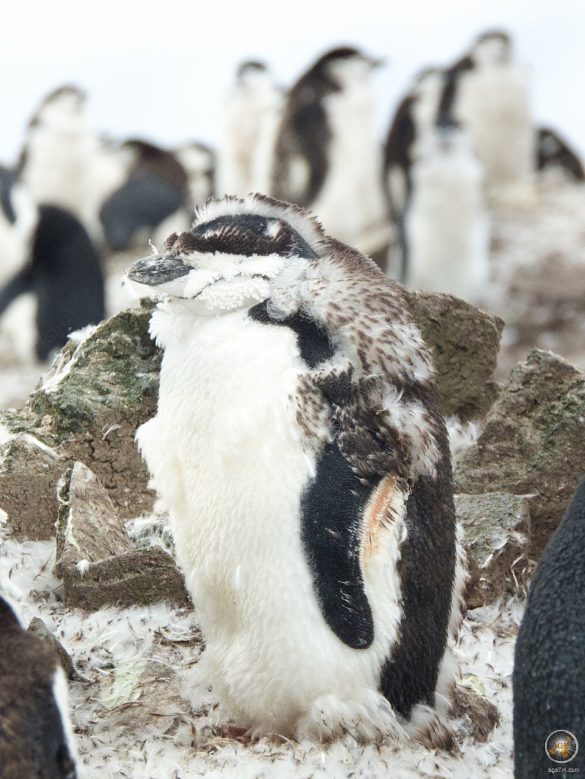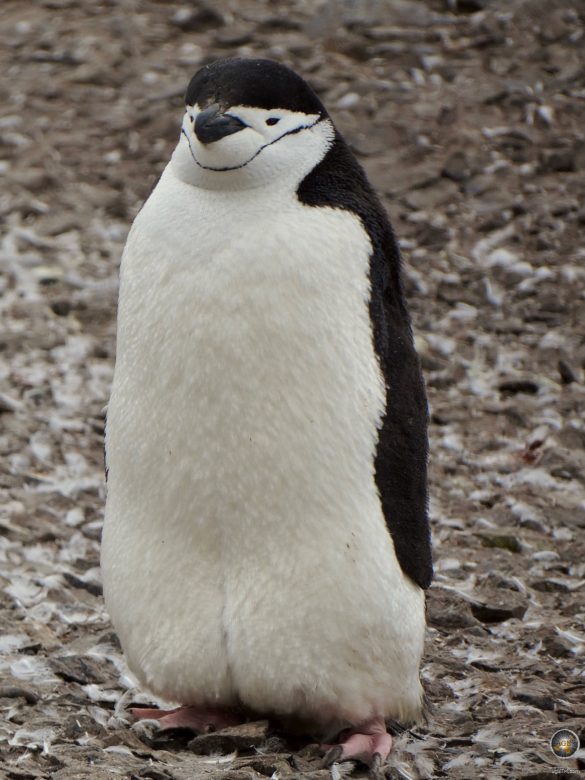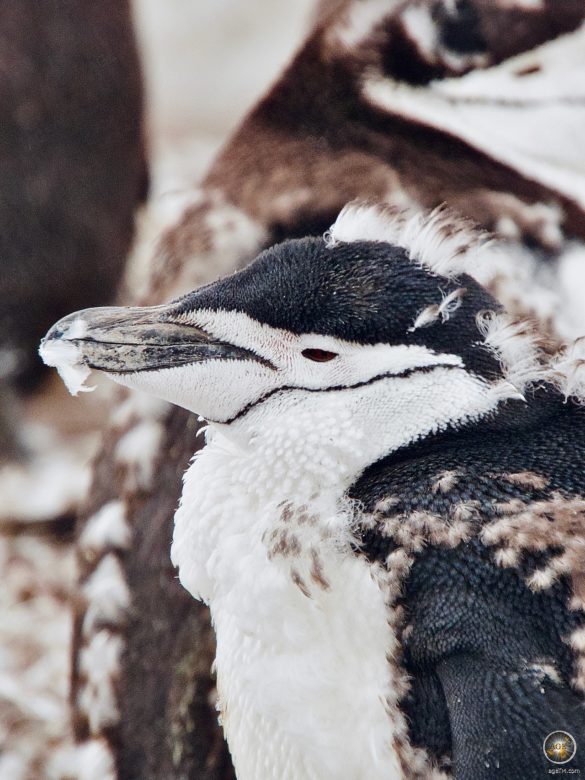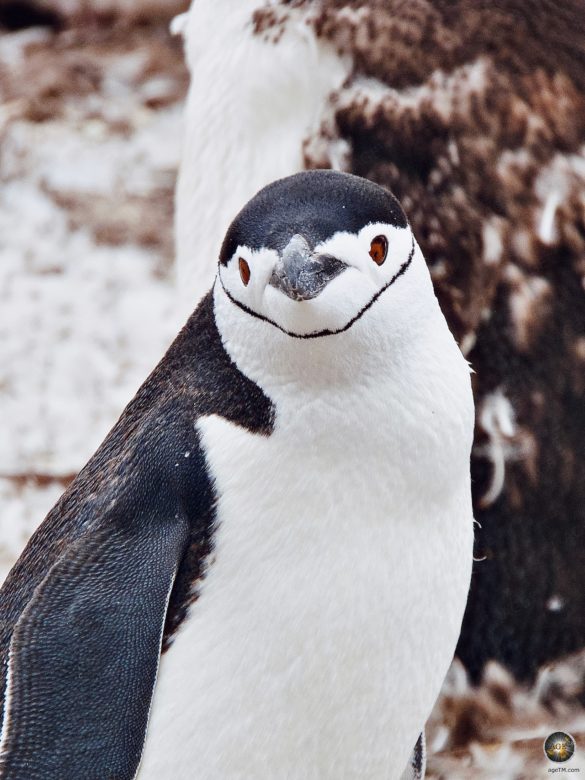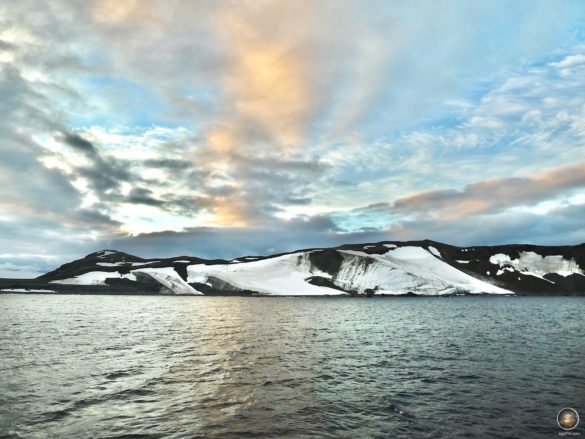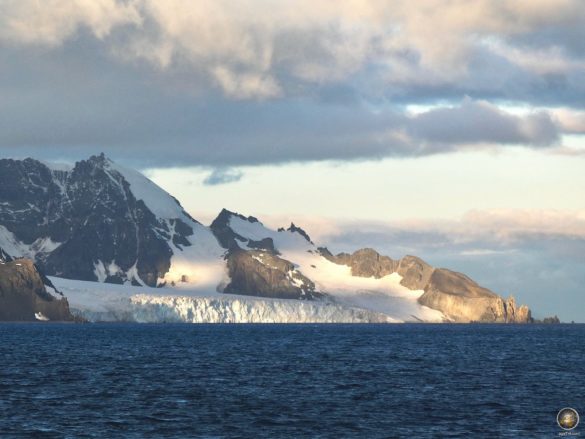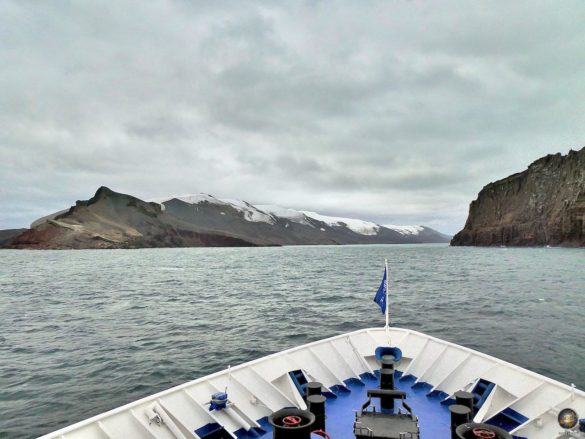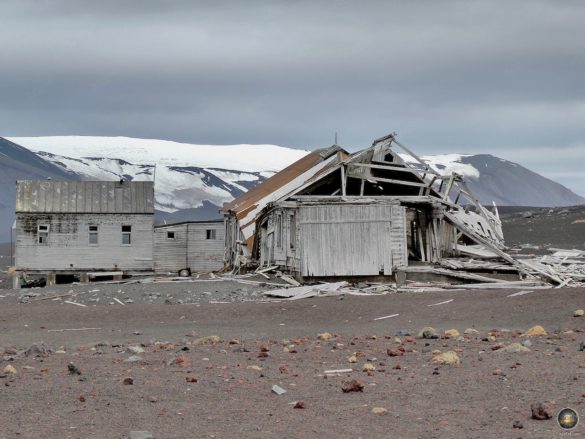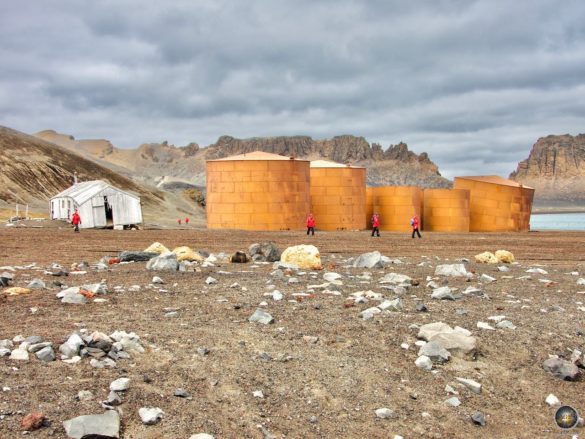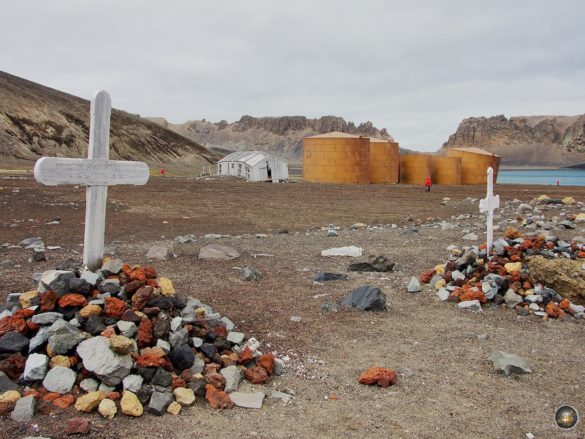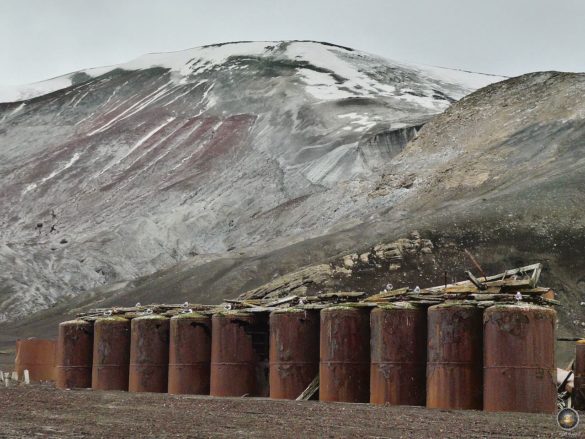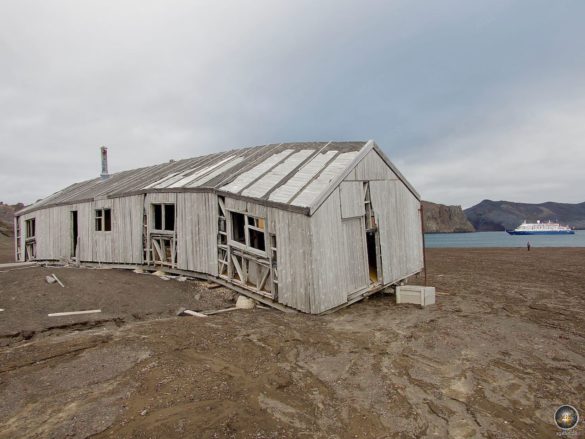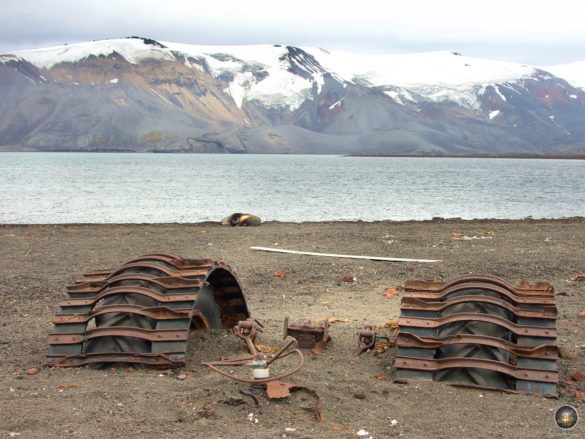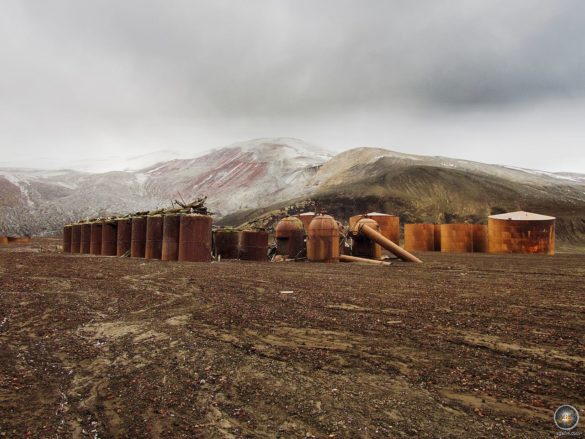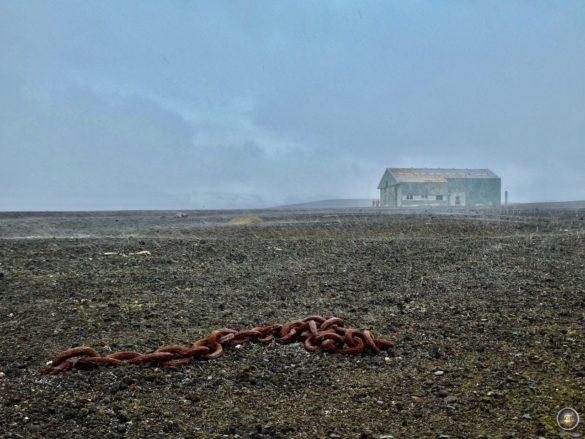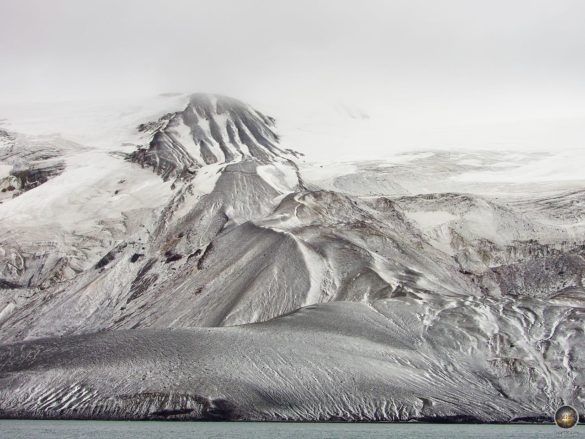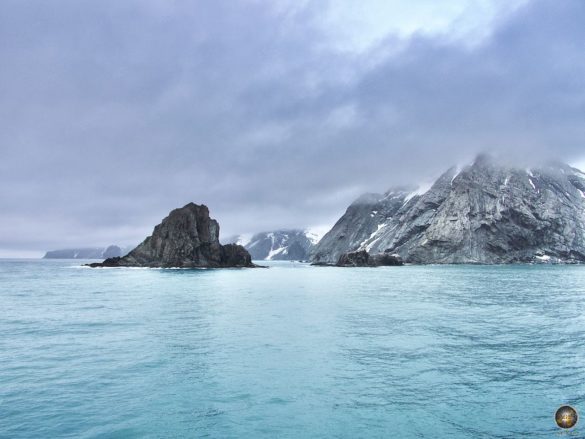Visit to the South Shetland Islands
Experience report part 1:
To the End of the World (Ushuaia) and Beyond
Experience report part 2:
The rugged beauty of the South Shetland Islands
1. South Shetland Islands: An idiosyncratic landscape
2. Halfmoon Island: Extended family of chinstrap penguins & Co
3. Deception Island: 1. Iceberg & A volcanic crater full of water
a) Hike in the middle of nowhere (Telephone Bay)
b) Visit to the old whaling station (Whaler's Bay)
4. Elephant-Island: The beach of Shackleton's men
5. Southern Ocean: whale watching off the coast of South Shetland
Experience report part 3:
Romantic tryst with Antarctica
Experience report part 4:
Among penguins in South Georgia
Antarctic Travel Guide • Antarctic trip • South Shetland & Antarctic Peninsula & South Georgia •
Expedition ship Sea Spirit • Field report 1/2/3/4
1. South Shetland Islands
An idiosyncratic landscape
land in sight! After two and a half days on the high seas, we can at least get a glimpse of what this sentence means for old sea dogs. The Beagle Channel and the Drake Passage we have left behind. Before us lies South Shetland, a sub-Antarctic archipelago. The South Shetland Islands are politically part of Antarctica and are therefore covered by the Antarctic Treaty. Like the Seventh Continent, the South Shetland Islands are currently owned by no one but their animal residents. So we've arrived.
Many passengers are wrapped up on the deck of the Sea Spirit, others enjoy the view with a windbreaker and a hot cup of tea on the balcony, a few people cling to the pane from the inside and the rest sit in the lobby with the picture window. No matter how: everyone stares outside, because there the lonely, rough landscape of the South Shetland Islands passes us by.
Unreal and beautiful in their own idiosyncratic way. And that's exactly why we're here, to marvel at this unique individuality. No pleasing colors, no postcard motifs of turquoise blue, palm trees and white sandy beaches. no Instead, dark cliffs, snowy mountain peaks, meter-high snowdrifts and jagged ice break edges of ancient glaciers drift in the endless gray-blue of the Southern Ocean. Land and sky merge. Hug each other. Unite tone on tone, only to finally dissolve into a delicate white-grey.
We pay our respects to the sub-Antarctic and literally soak up the sight of the first cold islands. We are indeed here. incarnate. Next to the gatekeepers of Antarctica. Our fingers are slowly getting stiff, the wind is knotting our hair and yet our smile is getting bigger. The ship has set course for Halfmoon Island. During the briefing by our expedition leader, we learned that this South Shetland island is particularly well known for its colony of chinstrap penguins. When the first penguins jump through the waves next to the ship's hull, it's clear: we're already very close.
Back to the overview of the experience report
Antarctic Travel Guide • Antarctic trip • South Shetland & Antarctic Peninsula & South Georgia •
Expedition ship Sea Spirit • Field report 1/2/3/4
2. South Shetland Island Halfmoon Island
Extended family of chinstrap penguins & Co
Everyone on deck! Jackets, rubber boots and life jacket. Here we go. The Expedition Team Sea Spirit has found a good spot for our first landing and is already launching the rest of the Zodiacs. With these small inflatable boats for extreme conditions we will visit many wonderful places in the next few days. A look at the waves, a sailor's grip, a courageous step and we're already sitting in the rubber boat and jetting towards our first landing.
Four chinstrap penguins form the reception committee. White bellies, black backs, and an incredibly cute face: white with a black crest, black beak, and a thin line across the cheeks. The quartet relaxedly preened between shimmering blue blocks of ice and then waddled hop, hop, hop across the dark pebble beach.
Only after an extensive photo session can we tear ourselves away from the cute penguins. I would love to watch the little hoppers for hours. They are kind enough to accompany us part of the way.
A small dilapidated wooden boat tells of transience. This innocent looking boat has a dark history. It is proof that, unfortunately, man has already overexploited this beautiful, remote place. For those interested, a member of the expedition team will reveal the dark secret: the inconspicuous boat wreck was an old whaling boat.
A few meters further, up the hill, we spot a white-faced waxbill, a typical bird of the Antarctic region. In the distance we can spot the penguin colony. The first passengers have already arrived there, but there is far too much to discover along the way for us to move forward quickly. We slowly follow the route of red flags that the team has marked out for us. So everyone can explore Halfmoon Island at their own pace. A very pleasant system.
Several fat fur seals cavort in the bay, a single female elephant seal lies in between, chinstrap penguins sit on small snowfields and glaciers and mountains tower in the background. On another stretch of coast, a couple of us suddenly waddle gentoo penguins opposite. They are similar in size to chinstrap penguins but have a black head with a large white patch over the eye and a distinctive orange beak. There is so much to see!
Finally we reach the chinstrap penguin colony. In small groups (which seem very, very large to us on our first day, because we compare to South Georgia do not know yet) the animals stand close together. They are in the middle of the moult and give a funny picture.
Some look extremely fat: puffed up, fluffy and so plush that you want to cuddle them. Some are totally torn and look like an old patchwork quilt. Others have already been finely smoothed and newly feathered, blossom-white. The floor is covered with soft down and all in all the little penguins remind us a lot of black and white down pillows after a long pillow fight.
Here ends our route for today. Two crossed flags put a stop to it. Up to here and no further. The penguins need rest during the moult. They can only eat again when they have completely changed their plumage. Penguins molt all their feathers at the same time. This is called a catastrophic moult, explains a local ornithologist from the expedition team. They are not waterproof in their current state, making it impossible for them to hunt in the freezing cold waves of the Southern Ocean. Fasting is the order of the day. To save energy, the animals move little. It is therefore important not to stress them and to keep a respectful distance. So we sit down, remain silent and enjoy the view over the colony.
Slowly we come to rest, put the cameras aside and take in this special moment. The mountains tower in the background and in front of us cute balls of feathers are dozing. We have arrived. I take a deep breath and, for the first time, consciously perceive the peculiar scent of the penguins. They have their very own, spicy smell. I let my eyes wander happily. I think they smell like space. This is the scent of Antarctica I want to remember.
Back to the overview of the experience report
Antarctic Travel Guide • Antarctic trip • South Shetland & Antarctic Peninsula & South Georgia •
Expedition ship Sea Spirit • Field report 1/2/3/4
3. South Shetland Island Deception Island
The 1st iceberg & a volcanic crater full of water
I open my eyes early in the morning and of course my first look is at the window. A beautiful mountainous landscape is already passing by there. So get out of bed and into the expedition jacket! We can sleep at home again. The last tiredness quickly dissipates in the Antarctic wind. I breathe crystal clear morning air and as the morning sun climbs the peaks, we glide past a beautiful glacial ridge that reaches down to the sea.
Eventually, the outline of Deception Island begins to take shape. Our goal for today. Deception means deception. A fitting name for an island that is actually an active volcano. No one would expect to be able to take the ship to their midst. Due to collapses and subsequent erosion of the crater rim, the partially emptied magma chamber was flooded with seawater. Once discovered, man has used this protective natural harbor for himself ever since.
Suddenly a structure in the distance catches my attention. iceberg ahead!
Indeed, our first iceberg. A massive beautiful colossus. Angular, rough and unpolished. A real floating mountain of snow and ice. While I'm still looking for the perfect image cut, I'm amazed again at how many shades of white nature has come up with.
Hard white with a hint of gray-blue, the iceberg floats in front of Deception Island. But the narrow coastal strip of South Shetland Island only becomes visible at second glance. Radiant and snow-white in the truest sense of the word, it shines delicately from behind the iceberg. Only to then appear to be reflected in the sky, through which the clouds run in white-grey and milky-white paths, while crystal-white crests of foam crown the Ozan. I'm sure: Nowhere else in the world will white appear as colorful to me as in Antarctica.
Finally, the ship approaches a narrow gap in the island's rock massif and our captain steers directly towards it. Deception Island is announced via loudspeaker and soon all passengers are standing at the railing to enter the Sea Spirit into the natural harbor of Deception Island. The narrow entrance to the flooded caldera is also called Neptune's Bellow's because strong winds often whistle through the constriction.
On the right a dark cliff rises, on the left a rising mountain range with colorful rock formations. If you look closely, you will see many small dots on the near-oceanic plateau. And the dots are penguins. The erosion gap that we drive is adorned with washed boulders and a free-standing rock needle. Breathlessly amazed, we alternately turn to the right and left, then we're done.
A protective mountain range rises around us and the water becomes calm. What we perceive as mountains is the crater rim. We are floating in the middle of the seawater lagoon of a flooded volcanic crater, in the center of a still active volcano below us. The notion is bizarre. But nothing around us indicates this spectacular fact and we feel completely safe. Is this certainty deceptive? The floor of the caldera is currently rising by around 30 cm every year, as we learn in the scientific lecture in the evening.
Something is in motion. It's probably a good thing that we don't know that exactly yet. Full of expectation we stand at the railing and look forward to the day on Deception Island relaxed and excited.
Back to the overview of the experience report
Antarctic Travel Guide • Antarctic trip • South Shetland & Antarctic Peninsula & South Georgia •
Expedition ship Sea Spirit • Field report 1/2/3/4
3. South Shetland Island Deception Island
a) Hike in the middle of nowhere (Telephone Bay)
Today it's hiking time in Telefon Bay: in the middle of nowhere in the volcanic landscape of Deception Island. Red flags mark the path and we decide to simply walk the marked out loop in the opposite direction. Only a handful of people do the same and climb up the steep mountain that everyone else will later walk down. It's worth swimming against the current. We are rewarded with fantastic views and above all with the feeling of solitude.
- View of the seawater filled caldera - Deception Island - South Shetland Islands - Sea Spirit Antarctic cruise
From up here you can see the entire lagoon. Our expedition ship floats in the center and suddenly looks tiny compared to the dimensions of this gigantic crater. From a bird's eye view, we see the crater shape much better and are beginning to get a feel for what our expedition team explained earlier.
- Huge Volcanic Crater with Lagoons - Deception Island South Shetland Islands - Sea Spirit Antarctica Voyage
After a meditative break we continue. Another bit up. Again and again we stop and enjoy the view back. It is only from this height that the beautiful turquoise shimmering foothills of the crater lagoon become clearly visible and a second, much smaller lake that shimmers yellowishly towards us.
- Volcano Craters and Landscape of Deception Island South Shetland Islands - Sea Spirit Antarctic Voyage
When we have reached the highest point, the first hikers come towards us. Embedded in the expanse of Deception Island, they appear small and inconspicuous, despite the bright red expedition jackets. From gently rising hills we look down into a weather-beaten and deeply indented volcanic landscape.
- Volcanic Craters on Deception Island South Shetland Islands - Sea Spirit Antarctic Voyage
We take our time, enjoy the view and capture beautiful photo motifs. Nevertheless, we completed the circular route faster than most. As trekking friends, we are used to rocky terrain and are actually just getting warm. Since we missed exercise anyway during the days at sea, we decide to just run the route again.
And so we enjoy the highlights of Telefon Bay twice: volcanic soils, mountainous expanses, great views, tiny people, sparkling lagoons and deeply carved valleys.
Back to the overview of the experience report
Antarctic Travel Guide • Antarctic trip • South Shetland & Antarctic Peninsula & South Georgia •
Expedition ship Sea Spirit • Field report 1/2/3/4
A barbecue with a view
Then it's time for lunch: today with a delicious barbecue on the deck of the Sea Spirit. Inselbergs in the background and fresh sea air in the nose - that's how lunch tastes twice as good. Well fed, everyone is ready for the next landing.
Back to the overview of the experience report
Antarctic Travel Guide • Antarctic trip • South Shetland & Antarctic Peninsula & South Georgia •
Expedition ship Sea Spirit • Field report 1/2/3/4
3. South Shetland Island Deception Island
b) Visit to an old whaling station (Whaler's Bay)
Deception Island's Whalers Bay is used by guests of the Sea Spirit perceived very differently. The statements vary from "What am I supposed to do here?" to "You have to see that." to "Fantastic photo opportunities." We are talking about the rusty remains of the former whaling station and the dilapidated buildings from its eventful history South Shetland Island. But at the end of the day we all agree: Thanks to Mother Nature, the trip was a complete success.
Seal hunting, whaling and processing whales in the world's southernmost blubber cookery shaped Deception Island in the first half of the 20th century. A sad past. Then, during World War II, the British destroyed all the facilities for fear they might fall into German hands. We stand helplessly for a moment in front of the ruins of time, stare at the huge rust-red tanks and have horrifying images in our heads.
Then we do the only logical thing: We throw ourselves into a photo shoot with sugar-sweet Antarctic fur seals.
Also known as fur seals, the beautiful animals were nearly wiped out during Deception Island's Dark Years. But fortunately they have returned, have multiplied successfully and have now reclaimed their habitat. They seem to know that they no longer have anything to fear from humans and remain perfectly calm despite our presence. We too relax and enjoy the beautiful view and the company of the funny sea dogs.
They lie everywhere. At the beach. in the moss. Even between the tanks. males and females. adults and juveniles. How nice that this is her island again today. A member of the expedition team draws our attention to the moss again. After all, we are in the Antarctic and for this area, mosses are an extremely lush vegetation that deserves a little attention.
Then we stray along the beach and explore the derelict buildings. A little history can't hurt. On our journey through the past we circle rusty tanks, peek into crooked windows, find ancient graves and the buried remains of a tractor in the sand. You are not allowed to enter the ruins. There is an acute danger of collapse.
I like the tractor best. It is impressive what ground masses must have moved in order for the vehicle to sink so deeply. A skuas next to wood and rusty nails makes me think again. It would make sense to clean up here. It's just a shame that that's exactly what's forbidden.
One of the passengers is an avid fan of Lost Places like this one. He is totally into it and asks a thousand questions about the buildings. The living quarters of the whaling station were converted into a research station by the British, the expedition team is currently telling. The aircraft hangar also dates from this period. No, the plane is no longer there. That has since been removed. Great Britain, Argentina and Chile have had stations here and have laid claims to the island. Two volcanic eruptions put an end to the dispute and the island was evacuated. The cemetery was also buried at that time. "And today?" Today, Deception Island falls under the Antarctic Treaty. The political claims of the states are dormant and the remains of the whaling station are protected as a heritage site.
Enough story for today. We are drawn back to the animal inhabitants of the island. To our great joy we discover two Gentoo penguins. They patiently pose for us and waddle eagerly back and forth between the fur seals.
Then the weather suddenly changes and nature transforms our excursion into something very special:
First, fog gathers and the mood suddenly changes. Somehow the mountains seem bigger than before. Tiny huts, volcanic land, a mighty rocky slope and all-consuming fog towers above. The scenery becomes mystical, nature is present and the deep gray intensifies the shading of the rock into bright colors.
- Ruins of Whalers Bay in the falling mist.
Then it starts raining. All of a sudden, like a secret command. Fine sleet pelts the black beach. The dark sand seems to get a little darker, a little rockier and more contrasting. In the distance, on the other hand, the contours blur, the clouds lower and the world blurs.
- Iron chain and airplane hangar in sleet.
Eventually the rain solidifies into snow. And before our eyes, the coast of Deception Island turns into a new fairyland. The painter of the air delicately traces the lines of the mountains. Every single contour. Like a pencil drawing. And when his work of art is finished, the snowfall stops immediately.
- Snowy coast of Deception Island.
We are fascinated by how the world around us is changing. Like a perfect theatrical production, only live. In just a few minutes all the mountains and hills on the coast are draped in a new white dress. It looks beautiful. Here too, in a lost place like this, nature has created a masterpiece for us.
Back to the overview of the experience report
Antarctic Travel Guide • Antarctic trip • South Shetland & Antarctic Peninsula & South Georgia •
Expedition ship Sea Spirit • Field report 1/2/3/4
4. South Shetland Island Elephant Island
The beach of Shackleton's men
The third South Shetland Island we visited on our Antarctic expedition with the Sea Spirit approach is Elephant Island.
A beautiful iceberg and a grandiose glacier await us as a welcoming committee. The ice masses flow directly into the sea and their reflection creates a delicate blue shimmer that stands out sharply against the dark rocky cliffs. The closer we get, the more impressive it is. With binoculars and telephoto lenses we explore its wildly rugged surface. He is breathtakingly beautiful.
Then we reach Point Wild. The place is named after Frank Wild, Ernest Shackleton's close confidant. During Ernest Shackleton's adventurous Endurance Expedition to Antarctica, his ship was trapped in the ice and eventually destroyed. The men's struggle for survival and the daring rescue mission is legendary. Frank Wild was in command of the remaining crew.
In the meantime, we have learned a lot about this Antarctic expedition from lectures on board and so we look at Elephant Island with a connoisseur's eye. The stretch of beach on this South Shetland island looks tiny. Here 28 men lived under three overturned rowing boats, persevered and waited for rescue for months. It's crazy that everyone actually survived. Today, at Point Wild, the monument to Luis Prado sits enthroned between chinstrap penguins. A bust of the Chilean captain that eventually helped Ernest Shackleton save his men.
A Zodiac trip was actually planned off Elephant Island, but unfortunately it's too wavy to switch to the small dinghies. It's not very windy, but waves regularly lap over the marina on the lowest deck. The waves that reach us from the high seas are too strong. Entry would be dangerous, at least for people who are not good on their feet or who are not seaworthy. Our expedition leader decides that the risk of injury is too great and the risk too great just to get a few more feet closer to the island. The swell is the problem, he explains apologetically and looks at disappointed faces. Then he quickly pulls an ace up his sleeve: Whale watching is the order of the day.
Instantly our faces brighten up again. Already on the way to Elephant Island we could spot a few fins in the distance when the captain had set course for the island. Now it's back with the plan to look for exactly this group and this time to observe it up close. Lift anchor: whales ahead!
Back to the overview of the experience report
Antarctic Travel Guide • Antarctic trip • South Shetland & Antarctic Peninsula & South Georgia •
Expedition ship Sea Spirit • Field report 1/2/3/4
4. Whale Watching in the Southern Ocean
Whales sighted off the coast of South Shetland
- Whale Watching on Antarctic Voyage with the Sea Spirit
- Fin whales (Balaenoptera physalus) in Antarctic waters
Blow, back, fin. Suddenly we are right in the middle. Fountains of water splash upwards everywhere. Right a blow, then left, a third further back. Only a few seconds at a time, the backs of the whales dip through the surface, allowing us a glimpse of a small piece of the majestic animals. We are breathless because there are so many.
- Humpback and fin whales in the Southern Ocean
- Back and blowholes of a fin whale in the Southern Ocean
Most are fin whales, but there are also a few humpback whales. Enthusiastic shouts accompany the spectacle. There – no there – and here. Fin whales, the second largest whale species in the world and we are lucky enough to meet a whole group. Craziness. Later, the sighting of around forty animals is entered in the logbook. Fourty. Even at dinner, all passengers have a big grin on their faces.
Back to the overview of the experience report
Antarctic Travel Guide • Antarctic trip • South Shetland & Antarctic Peninsula & South Georgia •
Expedition ship Sea Spirit • Field report 1/2/3/4
Excited how to proceed?
Experience a romantic rendezvous with Antarctica in part 3
Note: This article, as well as the following field reports, are currently still in progress.
Tourists can also discover South Shetland on an expedition ship, for example on the Sea Spirit.
Explore the lonely kingdom of the cold with the AGE™ Antarctic Travel Guide.
Antarctic Travel Guide • Antarctic trip • South Shetland & Antarctic Peninsula & South Georgia •
Expedition ship Sea Spirit • Field report 1/2/3/4
Enjoy the AGE™ Picture Gallery: The rugged beauty of South Shetland
(For a relaxed slide show in full format, simply click on one of the photos)
Antarctic Travel Guide • Antarctic trip • South Shetland & Antarctic Peninsula & South Georgia •
Expedition ship Sea Spirit • Field report 1/2/3/4
Poseidon Expeditions (1999-2022), Home page of Poseidon Expeditions. Traveling to Antarctica [online] Retrieved 04.05.2022-XNUMX-XNUMX, from URL: https://poseidonexpeditions.de/antarktis/


